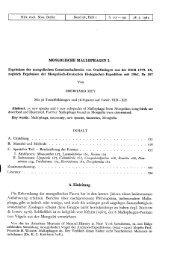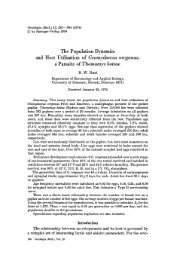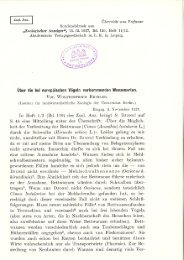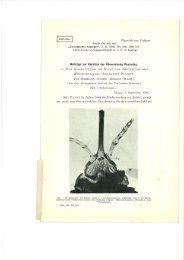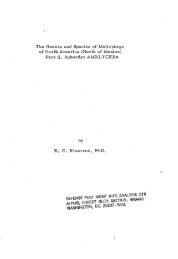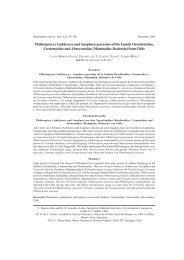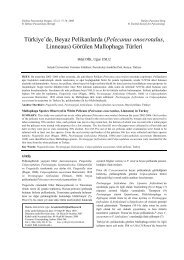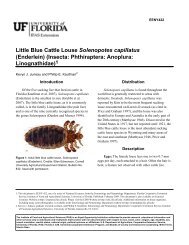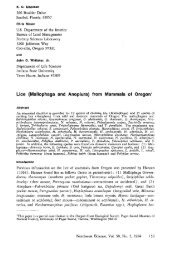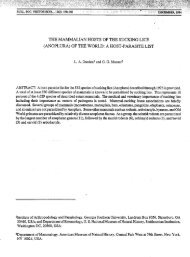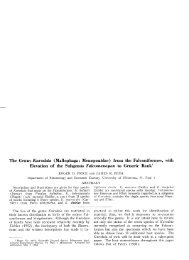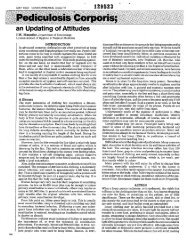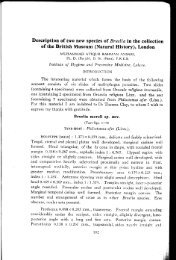The Geographical and Ecological Distribution of Arboreal Psocoptera
The Geographical and Ecological Distribution of Arboreal Psocoptera
The Geographical and Ecological Distribution of Arboreal Psocoptera
You also want an ePaper? Increase the reach of your titles
YUMPU automatically turns print PDFs into web optimized ePapers that Google loves.
Annu. Rev. Entomol. 1985.30:175-196. Downloaded from arjournals.annualreviews.org<br />
by Mr. Bas van Berkum on 10/10/07. For personal use only.<br />
Annual Reviews<br />
www.annualreviews.org/aronline<br />
Ann. Rev. EntomoL 1985.30:175-96<br />
Copyright © 1985 by Annual Reviews Inc. All rights reserved<br />
THE GEOGRAPHICAL AND<br />
ECOLOGICAL DISTRIBUTION<br />
OF ARBOREAL PSOCOPTERA<br />
Ian W. B. Thornton<br />
Department <strong>of</strong> Zoology, La Trobe University, Bundoora, Victoria, Australia 3083<br />
INTRODUCTION<br />
<strong>The</strong> order <strong>Psocoptera</strong> (the psocids) consists <strong>of</strong> some 36 families with perhaps<br />
5,000 species (some 3,000 described), <strong>and</strong> is generally considered to be the<br />
monophyletic sister group <strong>of</strong> the order Phthiraptera within the superorder<br />
Psocodea (32, 38, 69, 70). Fossils are known from the Permian, <strong>and</strong> most early<br />
fossils are generally placed in a separate suborder, Permopsocida. <strong>The</strong> earliest<br />
psocids are from the Kansas Lower Permian (75), <strong>and</strong> by the Oligocene most<br />
are referable to recent families <strong>and</strong> genera. <strong>The</strong> general biology <strong>and</strong> classification<br />
<strong>of</strong> the order has been the subject <strong>of</strong> several recent reviews (30, 62, 75,<br />
102).<br />
Some psocids occur in ground litter for a part or whole <strong>of</strong> their life cycle;<br />
others are found on rocks <strong>and</strong> in the nests <strong>of</strong> birds, rodents, <strong>and</strong> termites. A few<br />
species have been found in the feathers <strong>and</strong> fur <strong>of</strong> living birds <strong>and</strong> mammals. A<br />
number appear to live on herbs <strong>and</strong> grasses, <strong>and</strong> a few in moss, whereas others<br />
are found in caves (particularly Prionoglaridae <strong>and</strong> Psyllipsocidae). Several<br />
species are found in domestic habitats <strong>and</strong> use a wide range <strong>of</strong> foods that occur<br />
there.<br />
In this paper I attempt to review the present state <strong>of</strong> knowledge on the<br />
geographical <strong>and</strong> ecological distribution <strong>of</strong> those <strong>Psocoptera</strong> that inhabit trees<br />
<strong>and</strong> shrubs. <strong>The</strong> literature reviewed is largely confined to those publications<br />
appearing since 1964; the bibliography by Smithers (72) may serve as a source<br />
for earlier references.<br />
0066-4170/85/0101-0175502.00<br />
175
Annu. Rev. Entomol. 1985.30:175-196. Downloaded from arjournals.annualreviews.org<br />
by Mr. Bas van Berkum on 10/10/07. For personal use only.<br />
Annual Reviews<br />
www.annualreviews.org/aronline<br />
176 THORNTON<br />
<strong>Ecological</strong> Role<br />
FEEDING AND BIOMASS Although usually designated as scavengers or detritivores<br />
when ecological roles are assigned to the various components <strong>of</strong><br />
ecosystems, arboreal <strong>Psocoptera</strong> are in fact grazers, <strong>and</strong> their pastures are the<br />
microepiphytes (fungi, algae, <strong>and</strong> lichens) that grow on the bark <strong>and</strong>. leaves<br />
trees <strong>and</strong> shrubs <strong>and</strong> in the litter. Some also take pollen grains. <strong>The</strong> peculiarities<br />
<strong>of</strong> psocid mouthparts <strong>and</strong> the massive clypeal muscles may in the future be<br />
shown to be specifically related to this grazing type <strong>of</strong> feeding. <strong>The</strong> ecological<br />
importance <strong>of</strong> psocopterans in forest ecosystems has until recently been either<br />
neglected or assumed to be small. However, considerable information is now<br />
available on their role in temperate <strong>and</strong>, to a lesser extent, tropical forest<br />
ecosystems as a major component <strong>of</strong> the guild <strong>of</strong> microepiphyte feeders.<br />
In temperate forests the primary productivity contribution <strong>of</strong> microepiphytes<br />
may be comparable to that <strong>of</strong> the herb layer (92), <strong>and</strong> grazing psocids may make<br />
up a significant part <strong>of</strong> the biomass. Densities <strong>of</strong> over 4000/m2 on the bark <strong>of</strong><br />
larch (Larix decidua), equivalent to over 6000/m2 <strong>of</strong> l<strong>and</strong> surface, have been<br />
recorded in Yorkshire, Engl<strong>and</strong>, during late summer (16). <strong>The</strong> peak biomas s<br />
two species <strong>of</strong> Mesopsocus was about 1.2g/m2 <strong>of</strong> ~ bark surface, or about 2g/m<br />
<strong>of</strong> ground surface. This is comparable to the biomass <strong>of</strong> various kinds <strong>of</strong> big<br />
game animals such as antelopes feeding on grassl<strong>and</strong>s, <strong>and</strong> at peak times the<br />
grazing <strong>of</strong> microepiphytes by psocids can be very intense.<br />
In the tropics, psocid densities are much lower. However, in an altitudinal<br />
transect <strong>of</strong> canopy arthropods from sea level to 2400 m subtropical Hawaii<br />
(26), psocids were frequent <strong>and</strong> abundant on the two dominant trees examined<br />
<strong>and</strong> outnumbered all other taxa combined at mid <strong>and</strong> high elevations. Clearly,<br />
psocid populations can be important primary consumers <strong>and</strong> saprophages.<br />
PREDATION " In Britain a polyphagous mite <strong>of</strong> the genus Anystis is frequently<br />
recorded as a predator <strong>of</strong> psocids. In Yorkshire it may be responsible for much<br />
<strong>of</strong> the high mortality <strong>of</strong> first instar larvae <strong>of</strong> Philotarsus picicornis besides<br />
causing significant egg mortality in Mesopsocus species (23).<br />
In southern Engl<strong>and</strong>, spiders, mites, opilionids, neuropteran larvae, anthocorids,<br />
earwigs, <strong>and</strong> carabids have been reported to attack egg batches <strong>of</strong><br />
foliicolous psocids. Some 26 predators have been recorded (15, 99): the most<br />
important are spiders (by far), mites, opilionids, neuropteran larvae, <strong>and</strong><br />
coccinellid beetle. Of the three major groups <strong>of</strong> epiphyte herbivore:s on larch,<br />
the majority <strong>of</strong> predators select <strong>Psocoptera</strong> <strong>and</strong> Homoptera rather than the<br />
numerically more abundant Collembola.<br />
Ants (Crematogaster sp.) in Brazil have been seen at night attacking <strong>and</strong><br />
carrying <strong>of</strong>f archipsocids that live under large communal sheet-webs. In Florida<br />
archipsocids are preyed upon by Argentine ants <strong>and</strong> reduviid bugs.
Annu. Rev. Entomol. 1985.30:175-196. Downloaded from arjournals.annualreviews.org<br />
by Mr. Bas van Berkum on 10/10/07. For personal use only.<br />
Annual Reviews<br />
www.annualreviews.org/aronline<br />
DISTRIBUTION OF ARBOREAL PSOCOPTERA 177<br />
In Hawaii, larvae <strong>of</strong> the moth genus Eupithecia are ambush predators <strong>of</strong><br />
psocids (57) <strong>and</strong> will feed on them in the laboratory. This guild <strong>of</strong> predaceous<br />
Lepidoptera is endemic to the Hawaiian Isl<strong>and</strong>s, an area that also contains<br />
several endemic complexes <strong>of</strong> psocopterans. <strong>The</strong>se psocids constitute a considerable<br />
proportion <strong>of</strong> available prey for such predators. Larvae <strong>of</strong> endemic<br />
Neuroptera in Hawaii also prey on psocids, which are thought to have been<br />
their principal prey before the introduction <strong>of</strong> aphids.<br />
Sphecid wasps in Europe are known to take psocids occasionally; the<br />
stem-nesting Rhopalum claviceps, however, appears to specialize in psocids as<br />
prey. In France, R. claviceps is reported to attack 16 species, <strong>and</strong> many nests<br />
are wholly provisioned with psocids. In a Luxembourg garden, 25 species were<br />
found in 23 nests (68). From 1980 to 1983, N. Schneider (personal communication)<br />
examined 125 nests in Luxembourg <strong>and</strong> in 86 that were provisioned,<br />
all the prey were psocids (<strong>of</strong> 28 species), with an average <strong>of</strong> 24 per<br />
cell (270 cells). <strong>The</strong> wasp does not appear to discriminate between species<br />
between winged or apterous adults <strong>and</strong> nymphs. Apart from R. claviceps,<br />
arthropod predators appear to take psocids only as part <strong>of</strong> a wider spectrum <strong>of</strong><br />
prey.<br />
<strong>Psocoptera</strong>ns are the hosts <strong>of</strong> hymenopteran egg <strong>and</strong> larval parasites, some <strong>of</strong><br />
which seem to specialize on them as hosts. Some species even appear to show<br />
host-specificity within the order <strong>Psocoptera</strong>.<br />
Mymarid parasites <strong>of</strong> the genus Alaptus have been reared from psocids in<br />
many parts <strong>of</strong> the world, <strong>and</strong> it has been suggested that the geographical<br />
distribution <strong>of</strong> Alaptus coincides with that <strong>of</strong> arboreal psocids (62). In Engl<strong>and</strong>,<br />
there is evidence <strong>of</strong> habitat-based host specificity, with Alaptus life cycles<br />
closely correlated with those <strong>of</strong> their hosts. In both Engl<strong>and</strong> <strong>and</strong> Jamaica,<br />
parasitization has been related to the type <strong>of</strong> covering (feces, silk, or both)<br />
the egg masses <strong>of</strong> different psocid species, even when they occur on the same<br />
trees (23, 93).<br />
Braconids <strong>of</strong> the genera Euphoriella <strong>and</strong> Leiophron parasitize psocid<br />
nymphs in the Holarctic Region <strong>and</strong> in Central America. <strong>The</strong>y have not been<br />
recorded elsewhere, <strong>and</strong> New, who has dissected large numbers <strong>of</strong> psocid<br />
nymphs <strong>of</strong> several genera in South America <strong>and</strong> Australia, has speculated that<br />
braconid parasitization either does not occur in those continents or is extremely<br />
localized (62).<br />
Several papers cite circumstantial evidence Of bird predation on psocids, <strong>and</strong><br />
others from various parts <strong>of</strong> the world actually record predation by insectivorous<br />
birds (12, 13, 64, 85, 95, 98). In aviary experiments in Engl<strong>and</strong>, more dark<br />
than light morphs <strong>of</strong> apterous females <strong>of</strong>Mesopsocus unipunctatus were taken<br />
by great tits (Parus major) from larch branches with a covering <strong>of</strong> epiphytes<br />
than from bare branches; Popescu (65) suggested that visual selection by birds
Annu. Rev. Entomol. 1985.30:175-196. Downloaded from arjournals.annualreviews.org<br />
by Mr. Bas van Berkum on 10/10/07. For personal use only.<br />
Annual Reviews<br />
www.annualreviews.org/aronline<br />
178 THORNTON<br />
could maintain the color polymorphism in this industrial melanic psocid,<br />
provided that there was competition for "cryptic" resting sites.<br />
Various forms <strong>of</strong> crypsis have been noted occasionally in other psocids, <strong>and</strong><br />
avian predation may have provided selection pressure for this adaptation.<br />
Dorsal projections on the abdomen <strong>of</strong> apterous females <strong>of</strong> Hexacyrtoma,<br />
Gibbopsocus, <strong>and</strong> Camelopsocus resemble thorns <strong>and</strong> leaf scar swellings, <strong>and</strong><br />
species <strong>of</strong> Calopsocus <strong>and</strong> Calocaecilius resemble coccinellid beetles in<br />
appearance <strong>and</strong> movement. Nymphs <strong>of</strong> some Psocidae cover "gl<strong>and</strong>ular hairs"<br />
with adherent debris, <strong>and</strong> others make web shelters into which debris is<br />
incorporated. Many winged forms, such as myopsocids, have intricately patterned<br />
wings resembling their mosaic background. In Brazil, epipsocids <strong>and</strong><br />
archipsocids are partially cryptozoic by day <strong>and</strong> active at night, <strong>and</strong> ptiloneurids<br />
tend to be nocturnal. In their region <strong>of</strong> sympatry two North American<br />
species <strong>of</strong> Tapinella have a strikingly similar body pattern, <strong>and</strong> Mockford (47)<br />
has suggested that it may be advantageous for species to share a warning<br />
pattern.<br />
GEOGRAPHICAL DISTRIBUTION<br />
Although <strong>Psocoptera</strong> have been found in the sub-Antarctic isl<strong>and</strong>s, Tierra del<br />
Fuego, Finnish Lapl<strong>and</strong>, <strong>and</strong> in Outer Mongolia, few species are found in these<br />
extreme environments. For example, Mein<strong>and</strong>er (36), who collected extensively<br />
in northem Finl<strong>and</strong>, found only four species. In contrast, diversity is<br />
great in the tropics; Broadhead collected 295 species in Panama, <strong>and</strong> in<br />
Trinidad 116 species have been recorded from mango alone (17).<br />
Several species <strong>of</strong> psocids, most <strong>of</strong> which are domestic, are cosmopolitan in<br />
distribution, <strong>and</strong> others have wide tropical ranges. However, many regional<br />
faunas can be identified <strong>and</strong> many groups have limited distributions. Probably<br />
the least known faunas are those <strong>of</strong> southern Africa <strong>and</strong> tropical South America;<br />
<strong>and</strong> the Oriental region (notably peninsular India), the Indochina region, <strong>and</strong><br />
Wallacea (the region between Wallace’s <strong>and</strong> Weber’s lines that is a transitional<br />
zone between the Oriental <strong>and</strong> Australian regions) have been underc, ollected. In<br />
contrast, the faunas <strong>of</strong> Europe <strong>and</strong> North America are fairly well known, but<br />
even here discoveries <strong>of</strong> considerable biogeographical interest have; been made<br />
in recent years.<br />
<strong>Distribution</strong> patterns may be related to plate tectonic events in only a few<br />
cases. <strong>The</strong> small family Sphaeropsocidae consists <strong>of</strong> the genera Sphaeropsocus,<br />
which is known only from oligocene amber, Sphaeropsocopsi,~r, which has<br />
five species in Chile <strong>and</strong> one in each <strong>of</strong> southern Argentina, Tasmania, <strong>and</strong><br />
southern Africa, <strong>and</strong> Badonnelia, which has four species in Chile <strong>and</strong> one<br />
found in domestic situations in Europe. Apart from the European species, this<br />
family has a typical Gondwanian relict distribution <strong>and</strong> is the only known<br />
example <strong>of</strong> this type <strong>of</strong> distribution in the order <strong>Psocoptera</strong> (4, 5).
Annu. Rev. Entomol. 1985.30:175-196. Downloaded from arjournals.annualreviews.org<br />
by Mr. Bas van Berkum on 10/10/07. For personal use only.<br />
Annual Reviews<br />
www.annualreviews.org/aronline<br />
DISTRIBUTION OF ARBOREAL PSOCOPTERA 179<br />
Another small family whose distribution can be explained, at least tentatively,<br />
by plate movements is the Asiopsocidae. <strong>The</strong> three constituent genera occur<br />
in Mongolia, Mexico, Arizona, <strong>and</strong> Spain (Asiopsocus), the neotropics, southern<br />
Florida, <strong>and</strong> tropical Africa (Notiopsocus), <strong>and</strong> Brazil (Pronotiopsocus).<br />
This pattern suggests a very old, relict distribution. Character-state analysis<br />
showed Pronotiopsocus to be the sister group <strong>of</strong> the Notiopsocus-Asiopsocus<br />
line, <strong>of</strong> which Asiopsocus is the northern <strong>and</strong> Notiopsocus the southern vicariant.<br />
Mockford (52) suggested that the first phylogenetic event occurred prior<br />
to the breakup <strong>of</strong> Pangaea, <strong>and</strong> the second was coincident with it. <strong>The</strong> absence<br />
<strong>of</strong> Notiopsocus from Madagascar, India, <strong>and</strong> Australia may be because this<br />
evolutionary line reached Africa from South America too late to occur on the<br />
plate containing Antarctica, India, <strong>and</strong> Australia, which separated from Africa-<br />
Madagascar 205-160 Myr BP, <strong>and</strong> too late also to occur on Madagascar, which<br />
separated from Africa 172-90 Myr BP. Mockford (52) suggested that after the<br />
Pleistocene emergence <strong>of</strong> the Panama isthmus, Notiopsocus moved north into<br />
Mexico <strong>and</strong> southern Florida.<br />
<strong>The</strong> distribution <strong>of</strong> the larger family Philotarsidae may also be related to plate<br />
movements (81, 83). One subfamily, the Zel<strong>and</strong>opsocinae, with 65 species<br />
three genera, is confined to the Australian plate <strong>and</strong> its fragments; although<br />
well represented in New Caledonia <strong>and</strong> New Zeal<strong>and</strong>, it is absent from the<br />
Outer Melanesian Arc. Its sister group, the Philotarsinae, with 85 extant<br />
species, consists <strong>of</strong> two tribes--Philotarsini (Philotarsus <strong>and</strong> Haplophallus)<br />
<strong>and</strong> Aaroniellini (Aaroniella, Latrobiella, <strong>and</strong> Tarsophallus). Haplophallus<br />
has a gondwanan distribution (Africa, Australia, South America) with limited<br />
extensions, <strong>and</strong> it is absent from the Holarctic; Philotarsus is basically Holarctic.<br />
Of the Aaroniellini, Aaroniella is largely tropical, virtually absent from the<br />
Palaearctic <strong>and</strong> Africa, <strong>and</strong> has only one species in Australia. In contrast, its<br />
sister group, Latrobiella, occurs on the Australian plate <strong>and</strong> its fragments, on<br />
the Bismarcks <strong>and</strong> Solomons, <strong>and</strong> in southern South America. Tarsophallus is<br />
known only from the highl<strong>and</strong>s <strong>of</strong> East Africa (two species) (55) <strong>and</strong>, although<br />
no females are available, it appears to be the African sister group <strong>of</strong> Aaroniella<br />
<strong>and</strong> Latrobiella.<br />
Europe<br />
<strong>The</strong> number <strong>of</strong> species known from France has increased from 71 to 97 in the<br />
last 40 years, <strong>and</strong> 4 new genera have been discovered in Europe during the last<br />
decade. <strong>The</strong>se include a litter-dwelling amphipsocid from southern France,<br />
which is only the second representative <strong>of</strong> this family to be known from Europe;<br />
a new genus <strong>of</strong> the Mesopsocidae; a new electrentomid genus with a beetle-like<br />
habit, which is the first Troctopsocidae from outside the neotropics; <strong>and</strong> a new<br />
genus <strong>of</strong> the Pseudocaeciliidae, a family previously unknown from Europe <strong>and</strong><br />
best represented in the Oriental <strong>and</strong> Australian regions. <strong>The</strong> last genus, with
Annu. Rev. Entomol. 1985.30:175-196. Downloaded from arjournals.annualreviews.org<br />
by Mr. Bas van Berkum on 10/10/07. For personal use only.<br />
Annual Reviews<br />
www.annualreviews.org/aronline<br />
180 THORNTON<br />
three-segmented tarsi, is unique in the family; it is primitive in several respects<br />
but has apomorphous characters in common with Elipsocidae. <strong>The</strong>se recent<br />
discoveries are <strong>of</strong> biogeographical <strong>and</strong> phylogenetic interest <strong>and</strong> underscore the<br />
incompleteness <strong>of</strong> knowledge, even <strong>of</strong> such a well-investigated are, a.<br />
Recent work on European Elipsocidae (29) has shown that Hemineura dispar<br />
occurs in Sc<strong>and</strong>inavia, Estonia, <strong>and</strong> Germany <strong>and</strong> at high altitudes in Switzerl<strong>and</strong><br />
<strong>and</strong> France <strong>and</strong> in Moravia. Badonnel regarded the species as a postglacial<br />
relict; its southern limit is in the mountains <strong>of</strong> southern France where two<br />
congeneric species also occur, H. bigoti <strong>and</strong> H. hispanica, the latter also<br />
known from Spain,. Whereas dispar evidently has two generations per year, at<br />
least in Moravia, the two Mediterranean species are univoltine winter species.<br />
Both are parthenogenetic, with apterous females, but they differ from one<br />
another in aspects <strong>of</strong> biology <strong>and</strong> behavior. It is possible that all three species<br />
are glacial relicts, since dispar alone has survived in the north <strong>and</strong> extended to<br />
high locations in the south <strong>of</strong> its range; the other two persist only in the<br />
northwest Mediterranean area where they have a long resting stage in the egg<br />
<strong>and</strong> a short active generation in winter.<br />
<strong>The</strong> Atlantic isl<strong>and</strong>s have also recently received considerable attention (35,<br />
37). <strong>The</strong> Canary Isl<strong>and</strong>s, which are nearest to the mainl<strong>and</strong>, have 28 species (10<br />
endemic), followed by Madeira, with 19 (4 endemic). <strong>The</strong> Azores have<br />
species (4 endemic), <strong>and</strong> only 3 species (2 endemic) are known from the<br />
Verde Isl<strong>and</strong>s. Atlantopsocus (Psocidae), a genus that occurs in the Atlantic<br />
isl<strong>and</strong>s, comprises three species <strong>and</strong> is known from Irel<strong>and</strong>, Morocco, the<br />
Canaries, Madeira, <strong>and</strong> the Azores. Its closest relative appears to be Camelopsocus<br />
(54), <strong>of</strong> which five species are known from western North America.<br />
Mesopsocus, which is well represented in northwest Africa, extends only to the<br />
Canaries, where one species is endemic; this genus, in which most species have<br />
flightless females, is also absent from Madagascar (below). Twelve psocopteran<br />
species (four endemic) are known from Saint Helena (7); three <strong>of</strong> these<br />
cosmopolitan <strong>and</strong> four occur in Northwest Africa <strong>and</strong> the Atlantic isl<strong>and</strong>s<br />
mentioned above, possibly introduced by Portuguese maritime activity. Of the<br />
endemics, three have closely similar counterparts in West <strong>and</strong> Central Africa,<br />
<strong>and</strong> one is evidently an older endemic <strong>of</strong> unknown affinities.<br />
Ethiopian Region<br />
Coverage <strong>of</strong> Africa has been patchy; almost 80% <strong>of</strong> the species are known only<br />
from the type locality. <strong>The</strong> known fauna totals 493 species, <strong>and</strong> its relationships<br />
with those <strong>of</strong> Madagascar <strong>and</strong> the Mascarene isl<strong>and</strong>s have recently been<br />
considered. In West Africa 160 species are known, in East Africa 155 (20, 21),<br />
<strong>and</strong> in southern Africa 239 species are recorded from Angola (9) <strong>and</strong> 90 from<br />
other areas. Africa is rich in a number <strong>of</strong> families while others that are well<br />
represented elsewhere, such as Lachesillidae <strong>and</strong> Philotarsidae, are absent or<br />
have only few species.
Annu. Rev. Entomol. 1985.30:175-196. Downloaded from arjournals.annualreviews.org<br />
by Mr. Bas van Berkum on 10/10/07. For personal use only.<br />
Annual Reviews<br />
www.annualreviews.org/aronline<br />
DISTRIBUTION OF ARBOREAL PSOCOPTERA 181<br />
<strong>The</strong> family Mesopsocidae appears to have its center <strong>of</strong> diversity in Africa; it<br />
is absent from Neotropical <strong>and</strong> Australian regions <strong>and</strong> Madagascar <strong>and</strong> only<br />
weakly represented in the Nearctic <strong>and</strong> Oriental regions (21). <strong>The</strong> genera<br />
Hexacyrtoma <strong>and</strong> Labocoria are African, <strong>and</strong> Psoculus occurs in Europe <strong>and</strong><br />
Africa. <strong>The</strong> largest genus, Mesopsocus (40 species, 29 described), has<br />
species in the Ethiopian region, 14 in the Palaearctic (three also occurring in the<br />
Nearctic), <strong>and</strong> one in the Oriental region.<br />
Of three East African mountain massifs, Mount Kenya, the Aberdares, <strong>and</strong><br />
the Empakaai region, the first two, which are closest to one another, were<br />
found to have the most similar psocopteran faunas <strong>and</strong> each had 19% endemicity,<br />
whereas the endemicity <strong>of</strong> the more isolated Empakaai region was 41%.<br />
<strong>The</strong>re is a parallel here with geographical archipelagos (80). A closely related<br />
group <strong>of</strong> four species <strong>of</strong> Mesopsocus, all with apterous females, occurs at high<br />
elevations on mounts Kenya <strong>and</strong> Kilimanjaro (one species), Mount Kenya <strong>and</strong><br />
the Aberdares (one), <strong>and</strong> Empakaai (two). A fifth species with apterous<br />
females is evidently restricted to the shores <strong>of</strong> Lake Naivasha, <strong>and</strong> a sixth is<br />
found on Mount Kenya, the Aberdares, <strong>and</strong> Empakaai. In the last case, the<br />
differentiation <strong>of</strong> an Empakaai species appears to have been impeded by the<br />
presence (unusual in Mesopsocus) <strong>of</strong> winged females (21).<br />
In West Africa the psocid fauna <strong>of</strong> the 250 km wide Togo-Benin gap, which<br />
separates the rain forests to the west from those <strong>of</strong> Nigeria <strong>and</strong> Central Africa to<br />
the east, has affinities with eastern rather than western regions (101). Six <strong>of</strong> the<br />
28 species collected from the gap link it with the eastern regions; no Ivory Coast<br />
or Guinea species occurred in the collections. Of the 12 new species found in<br />
the Gap, only 2 have affinities with western species, <strong>and</strong> both are widespread;<br />
the most similar counterparts <strong>of</strong> the other 10 species occur to the east. More<br />
collecting to the west is needed to confirm the isolation <strong>of</strong> the western forest<br />
bloc species from those <strong>of</strong> the main body <strong>of</strong> equatorial rain forest, a finding<br />
which would lend support to the hypothesis that the lowl<strong>and</strong> forest isolate to the<br />
west was confined to refugia during arid glacial periods.<br />
<strong>The</strong> Madagascar fauna has all the features <strong>of</strong> insularity; 166 <strong>of</strong> the 197<br />
species are endemic (84%) as are 6 <strong>of</strong> 37 genera (16%) (3, 6). Endemic species<br />
complexes exist in eight genera. <strong>The</strong> species flocks <strong>of</strong> Thylacella, Amphientomum,<br />
Ctenopsocus, <strong>and</strong> Blastopsocidus are each thought to derive from a<br />
single founder, whereas those <strong>of</strong> Myopsocus <strong>and</strong> Ptycta represent two lines (3).<br />
Explosive speciation is also evident in Caecilius (26 species, 24 endemic) <strong>and</strong><br />
Amphipsocus (29 species, all endemic). Radiation is greatest in the amphipsocid<br />
subtribe Amphipsocina, which has three endemic genera. Notable absences<br />
<strong>of</strong> groups well represented in Africa include the genera Belapha, Fulleborniella,<br />
Ectopsocopsis, Myopsocus, the families Elipsocidae <strong>and</strong> Mesopsocidae,<br />
<strong>and</strong> the subfamily Cerastipsocinae <strong>of</strong> the Psocidae. Nevertheless, links with<br />
Africa are evident. <strong>The</strong> genera Paracaecilius, Epipsocopsis, Harpezoneura,<br />
<strong>and</strong> Blastopsocidus are only known from Africa <strong>and</strong> Madagascar, <strong>and</strong> there are
Annu. Rev. Entomol. 1985.30:175-196. Downloaded from arjournals.annualreviews.org<br />
by Mr. Bas van Berkum on 10/10/07. For personal use only.<br />
Annual Reviews<br />
www.annualreviews.org/aronline<br />
182 THORNTON<br />
seven cases <strong>of</strong> species pairs with a member <strong>of</strong> each occurring in Africa <strong>and</strong><br />
Madagascar; other species pairs appear to represent a more recent disjunction<br />
within Madagascar itself.<br />
<strong>The</strong> Mascarene Isl<strong>and</strong>s, Reunion <strong>and</strong> Mauritius, together have a fauna <strong>of</strong> 44<br />
species, half <strong>of</strong> which is endemic to the group. <strong>The</strong> isl<strong>and</strong>s have know faunas <strong>of</strong><br />
34 (12 endemic) <strong>and</strong> 16 (6 endemic) species respectively, with 6 species<br />
common (4 endemic) (2, 10, 94). Three genera endemic--lsophanopsis<br />
(Caeciliidae) on Reunion <strong>and</strong> Mockfordiella (Caeciliidae) <strong>and</strong> Mascaropsocus<br />
(Peripsocidae) on both isl<strong>and</strong>s. <strong>The</strong> fauna has remarkably little affinity with<br />
that <strong>of</strong> Madagascar. For example, the relationships <strong>of</strong> the Reunion endemics<br />
with Madagascar are few <strong>and</strong> probably represent very old phylogenetic events;<br />
present conditions are unfavorable for faunal exchange.<br />
North America <strong>and</strong> the Neotropics<br />
About a score <strong>of</strong> North American species have Holarctic distributions. Some<br />
may be true relicts, but about half are probably the result <strong>of</strong> recent introductions<br />
(49, 50).<br />
Lachesilla, one <strong>of</strong> the largest genera in the order with almost 300 recognized<br />
species (27; A. N. Garcia-Aldrete personal communication), has its chief<br />
representation in North America (over 120 species endemic). Of the 18 species<br />
groups recognized, all are represented in the Americas <strong>and</strong> all but two in North<br />
<strong>and</strong> Central America. Only three groups extend beyond the New World to<br />
Africa (all), Europe (one), <strong>and</strong> Madagascar (one).<br />
Systematic studies <strong>of</strong> the cerastipsocine Psocidae suggest an early New<br />
World radiation with African <strong>and</strong> Oriental groups as derivatives (51).<br />
example <strong>of</strong> a monophyletic group confined to Central <strong>and</strong> North America is<br />
Kaestneriella (Peripsocidae) (56).<br />
Recent work on the North American fauna has concentrated on detailed<br />
continental distributions <strong>of</strong> species (25), species pairs (48), <strong>and</strong> species groups<br />
(14, 40, 41, 43-45, 53). Many <strong>of</strong> these distributions may be related to the<br />
effects <strong>of</strong> glacial changes (disruptions <strong>of</strong> previously continuous ranges, Pleistocene<br />
refugia, <strong>and</strong> early Tertiary invasions from the south).<br />
In view <strong>of</strong> the massive representation <strong>of</strong> Lachesilla on the continent it is<br />
remarkable that only four species occur in Cuba, only one <strong>of</strong> which is unknown<br />
elsewhere. Of the 68 psocids known from Cuba (8, 46), 35 (51%) are presumed<br />
endemics. About half have close relatives in the Caribbean area or the adjacent<br />
mainl<strong>and</strong>, <strong>and</strong> in the Psocidae the genera Blaste <strong>and</strong> Indiopsocus have closely<br />
related groups <strong>of</strong> species that are probably autochthonous. <strong>The</strong>re is no endemic<br />
genus. Most <strong>of</strong> the widespread tropical species occur also in Africa <strong>and</strong> were<br />
possibly introduced to the American tropics during the slave trade.<br />
Jamaica has also been surveyed (93), <strong>and</strong> 83 species are known./kgain, there
Annu. Rev. Entomol. 1985.30:175-196. Downloaded from arjournals.annualreviews.org<br />
by Mr. Bas van Berkum on 10/10/07. For personal use only.<br />
Annual Reviews<br />
www.annualreviews.org/aronline<br />
DISTRIBUTION OF ARBOREAL PSOCOPTERA 183<br />
are no endemic genera, <strong>and</strong> again remarkably few species (three, two endemic)<br />
<strong>of</strong> Lachesilla occur there. Several genera have speciated in the highl<strong>and</strong>s, <strong>and</strong><br />
55 species (66%) are presumed endemics. Fourteen species are neotropical,<br />
five African, <strong>and</strong> nine cosmopolitan or tropicopolitan. <strong>The</strong>re are few species in<br />
common with Cuba.<br />
In both Cuba <strong>and</strong> Jamaica there are rather few affinities with Mexico, <strong>and</strong><br />
whereas links with the Floridean paxt <strong>of</strong> North America have been detected in<br />
the case <strong>of</strong> Cuba, South America has been suggested as a main source area for<br />
Jamaica. <strong>The</strong> very weak representation <strong>of</strong> Lachesilla <strong>and</strong> weak affinities with<br />
Central America argue against a l<strong>and</strong> connection to the west, <strong>and</strong> the hurricane<br />
patterns in the Caribbean are in accord with the Floridean <strong>and</strong> South American<br />
affinities suggested. A further 40-50 species are known from other Caribbean<br />
isl<strong>and</strong>s (11, 24, 42, 43), over half <strong>of</strong> which are endemic to individual isl<strong>and</strong>s;<br />
they include 6 <strong>of</strong> the 10 species <strong>of</strong> the Caribbean genus Spurostigma, 3 <strong>of</strong> the<br />
endemic genus Troctopsocopsis, <strong>and</strong> a largely Caribbean group <strong>of</strong> Caecilius.<br />
Additional collections, both in the Caribbean <strong>and</strong> mainl<strong>and</strong> areas to the south,<br />
are needed before hypotheses <strong>of</strong> Caribbean psocid biogeography can be formulated.<br />
Groups well represented in the neotropics include the families Pachytroctidae,<br />
Archipsocidae, Epipsocidae, <strong>and</strong> Liposcelidae <strong>and</strong> the amphipsocid genus<br />
Polypsocus. <strong>The</strong> Neurostigmatidae, Spurostigmatidae, Thyrosophorinae (Psocidae),<br />
<strong>and</strong> the genera Steleops <strong>and</strong> Dasydemella are confined to the region<br />
while the Troctopsocidae, Dolabellopsocidae, <strong>and</strong> Ptiloneuridae each have but<br />
a single species outside South America (in Europe, India-China, <strong>and</strong> Africa<br />
respectively). Endemic genera include Spurostigma, Isthmopsocus, <strong>and</strong><br />
Dolabellopsocus. Some otherwise rather widespread families are absent (Psilopsocidae,<br />
Mesopsocidae) <strong>and</strong> others are relatively weakly represented (Lepidopsocidae,<br />
Amphientomidae, Ectopsocidae, Elipsocidae, Myopsocidae, Philotarsidae,<br />
<strong>and</strong> Stenopsocidae). It is thus possible to characterize the neotropical<br />
psocopteran fauna in these general terms.<br />
<strong>The</strong> known Galapagos fauna (90) comprises 40 species, <strong>and</strong> where affinities<br />
can be determined they appear to be largely with the above region. Two species<br />
<strong>of</strong> Indiopsocus are <strong>of</strong> particular interest. I. dentatus is related to species from<br />
the Caribbean, the gulf coast <strong>of</strong> Mexico, <strong>and</strong> southern Florida (E. L. Mockford,<br />
personal communication); it occurs at low <strong>and</strong> high altitudes <strong>and</strong> is on almost<br />
all Galapagos isl<strong>and</strong>s. I. acraeus appears to be most closely related to I.<br />
expansus, known from the Colombian Andes at 2750 m. In contrast to I.<br />
dentatus it is a high altitude stenotope, found only on high isl<strong>and</strong>s at elevations<br />
above 500 m. In both species, differences between isl<strong>and</strong> populations <strong>and</strong><br />
between isolates on volcanoes <strong>of</strong> a single isl<strong>and</strong> have been recognized, <strong>and</strong><br />
peripheral isolates are more differentiated than those on more centrally located,<br />
less isolated isl<strong>and</strong>s or volcanoes (I. W. B. Thornton, unpublished). Correla-
Annu. Rev. Entomol. 1985.30:175-196. Downloaded from arjournals.annualreviews.org<br />
by Mr. Bas van Berkum on 10/10/07. For personal use only.<br />
Annual Reviews<br />
www.annualreviews.org/aronline<br />
184 THORNTON<br />
tion between differentiation <strong>and</strong> isolation is greater for the stenotopic acraeus<br />
than for the eurytopic dentatus, <strong>and</strong> it appears that both are actively speciating<br />
on the archipelago. In view <strong>of</strong> the known geological history (31),. dispersal<br />
rather than fragmentation events appear to have been the likely precursors <strong>of</strong><br />
differentiation both between archipelago populations <strong>and</strong> between the continental<br />
<strong>and</strong> Galapagos species. A related species, I. texanus, was an early <strong>and</strong><br />
regular colonizer <strong>of</strong> Florida mangrove islets defaunated by tent fumigation<br />
(71).<br />
Temperate South America<br />
<strong>The</strong> temperate South American fauna is rather better known than that <strong>of</strong> the<br />
tropics, particularly west <strong>of</strong> the Andes. Many groups that are typical <strong>of</strong> the<br />
tropics are lacking, <strong>and</strong> the characteristic genus Ptenopsila is endemic to the<br />
region. <strong>The</strong> temperate fauna is less diverse; only a few species are both frequent<br />
<strong>and</strong> abundant, a situation similar to that in northern latitudes. <strong>The</strong> Elipsocidae<br />
appear to have radiated particularly in Chile, where the genera Eolachesilla <strong>and</strong><br />
Roesleria are endemic <strong>and</strong> Nothopsocus is endemic to Chile <strong>and</strong> the Juan<br />
Fern<strong>and</strong>ez Isl<strong>and</strong>s. Although Chile may be regarded as an ecological isl<strong>and</strong><br />
with the Atacama desert to the north <strong>and</strong> mountains to the east, the Andean<br />
barrier declines in significance in the south as the range becomes lower <strong>and</strong><br />
eventually runs into the sea. <strong>The</strong> Valdivian forests possess a rich <strong>and</strong> varied<br />
fauna; the more southern Magellanic forests, dominated by Noth<strong>of</strong>agus, are<br />
impoverished, with an attenuated fauna (63).<br />
<strong>The</strong> arboreal psocid fauna <strong>of</strong> Argentina appears to include southward incursives,<br />
<strong>and</strong> many species there do not occur in Chile. However, in the south, at<br />
least two <strong>of</strong> the four most abundant Chilean species are trans-Andean. <strong>The</strong><br />
Embidopsocinae <strong>and</strong> Pachytroctidae, which are well represented in Brazil <strong>and</strong><br />
Argentina, have not been found in Chile, <strong>and</strong> Sphaeropsocidae appear to be<br />
rare east <strong>of</strong> the Andes yet have nine species in Chile (4). In other genera several<br />
species pairs with a member on each side <strong>of</strong> the Andes have been noted (1).<br />
Of the Juan Fern<strong>and</strong>ez group, only Robinson Crusoe (Mas a Tierra) has been<br />
surveyed (88). <strong>The</strong> nine known species comprise an endemic complex <strong>of</strong> five<br />
Nothopsocus species, a species widely distributed it/Chile, <strong>and</strong> three with an<br />
extensive range <strong>and</strong> probably recently introduced. Remarkably, on the Chilean<br />
mainl<strong>and</strong> Nothopsocus is represented by only two species, which are neither<br />
widely distributed nor common. In contrast, the genus Drymopsocus (also<br />
Elipsocidae), which has four widely distributed species in Chile, was not found<br />
on Robinson Crusoe. Possibly, ecological exclusion is responsible for these<br />
contrasting patterns. <strong>The</strong> families Caeciliidae <strong>and</strong> Philotarsidae, both common<br />
in Chile, also appear to be absent from Robinson Crusoe. <strong>The</strong> Galapagos <strong>and</strong><br />
Robinson Crusoe faunas are strikingly different; elipsocids are not known from<br />
the Galapagos, <strong>and</strong> only Peripsocus nitens, abundant on the Chilean mainl<strong>and</strong>,<br />
is probably common to the two.
Annu. Rev. Entomol. 1985.30:175-196. Downloaded from arjournals.annualreviews.org<br />
by Mr. Bas van Berkum on 10/10/07. For personal use only.<br />
Annual Reviews<br />
www.annualreviews.org/aronline<br />
DISTRIBUTION OF ARBOREAL PSOCOPTERA 185<br />
Links between the southern South American fauna <strong>and</strong> that <strong>of</strong> the Australian<br />
region are few--the Sphaeropsocidae <strong>and</strong> the genera Haplophallus (Philotarsidae)<br />
<strong>and</strong> Drymopsocus are examples--<strong>and</strong> the most typical species <strong>of</strong> temperate<br />
South America, Ptenopsila delicatella, has no analogue in temperate<br />
Australia.<br />
Australia <strong>and</strong> New Zeal<strong>and</strong><br />
Tropical Australia’s fauna includes a few representatives <strong>of</strong> basically Oriental-<br />
Papuan-Melanesian groups, such as the Calopsocidae, Psilopsocidae, subgroups<br />
<strong>of</strong> the Myopsocidae, Psocidae, <strong>and</strong> Amphipsocidae, <strong>and</strong> other more<br />
widespread tropical groups, e.g. Archipsocidae, Hemipsocidae, <strong>and</strong> Epipsocidae,<br />
which are absent from temperate regions <strong>of</strong> the continent. In the south the<br />
Elipsocidae (Propsocinae) <strong>and</strong> Philotarsidae are characteristic. Few strong<br />
affinities with isl<strong>and</strong>s <strong>of</strong> the western Pacific have been discerned. <strong>The</strong> philotarsid<br />
subfamily Zel<strong>and</strong>opsocinae is endemic to Australia <strong>and</strong> fragments <strong>of</strong> the<br />
Australian plate, <strong>and</strong> for this distribution a vicariance explanation is sufficient<br />
<strong>and</strong> appropriate. <strong>The</strong> elipsocid subfamily Propsocinae also appears to have its<br />
headquarters in this region: the widespread Propsocus occurs in Australia,<br />
Tasmania, South Africa, Chile, <strong>and</strong> Hawaii, Pentacladus in Australia, Antarctopsocus<br />
on Marion Isl<strong>and</strong> <strong>and</strong> the Crozet Isl<strong>and</strong>s, <strong>and</strong> Spilopsocus in Australia,<br />
Lord Howe Isl<strong>and</strong>, New Zeal<strong>and</strong>, <strong>and</strong> Campbell Isl<strong>and</strong>.<br />
In general, the New Zeal<strong>and</strong> fauna (73) appears to be a reduced Australian<br />
fauna (74). Here biological interest centers on the genus Austropsocus (Philotarsidae),<br />
which in this area exhibits a tendency towards flightlessness. Most<br />
species <strong>of</strong> the main isl<strong>and</strong>s have flightless females, while the species on the<br />
Chathams <strong>and</strong> that on the Campbell Plateau isl<strong>and</strong>s <strong>and</strong> Macquarie are flightless<br />
in both sexes. Except in the case <strong>of</strong> Macquarie, the presence <strong>of</strong> related<br />
flightless isl<strong>and</strong> species can be sufficiently explained by fragmentation events;<br />
the species common to Macquarie <strong>and</strong> the Campbell Plateau isl<strong>and</strong>s, which are<br />
geologically unrelated, is more difficult to account for (81).<br />
Oriental Region<br />
Knowledge <strong>of</strong> this fauna, crucial to an interpretation <strong>of</strong> Melanesian zoogeography,<br />
is insufficient. Recent expeditions somewhat augmented the basic work <strong>of</strong><br />
Enderlein on this region, but more work is needed. As an example, 10 days <strong>of</strong><br />
collecting on Bali <strong>and</strong> Lombok recently raised the number <strong>of</strong> species known<br />
from Indonesia from 140 to over 200.<br />
A few typically Oriental groups have been recognized. <strong>The</strong> family Calopsocidae<br />
extends from the Oriental region to northern Australia <strong>and</strong> the Solomons,<br />
with endemic genera in New Guinea (89). <strong>The</strong> Oriental group <strong>of</strong> Epipsocidae<br />
more closely related to African than tropical South American species; Epipsocopsis<br />
has distinct African <strong>and</strong> Oriental species groups, <strong>and</strong> Hinduipsocus is<br />
endemic to India.
Annu. Rev. Entomol. 1985.30:175-196. Downloaded from arjournals.annualreviews.org<br />
by Mr. Bas van Berkum on 10/10/07. For personal use only.<br />
Annual Reviews<br />
www.annualreviews.org/aronline<br />
186 THORNTON<br />
Although New Guinea has been inadequately surveyed, there are indications<br />
that it has been an important link between the greater Sunda isl<strong>and</strong>s <strong>and</strong> the<br />
isl<strong>and</strong>s <strong>of</strong> the Outer Melanesian Arc in the case <strong>of</strong> the Pseudocaeciliidae,<br />
Peripsocidae, Ectopsocidae, a subgroup <strong>of</strong> the Myopsocidae, <strong>and</strong> Calopsocus<br />
(Calopsocidae) <strong>and</strong> Epipsocopsis (Epipsocidae) (77, 89). Considerable evolution<br />
has occurred in New Guinea itself with the production <strong>of</strong> seven endemic<br />
genera. <strong>The</strong>re is also speculation that differentiation <strong>of</strong> philotarsid genera may<br />
have occurred in the area, where several unusual forms are found (77, 86).<br />
Relatively recent contributions from the New Guinea area to the faunas <strong>of</strong><br />
northeast Australia in the above families <strong>and</strong> the Stenopsocidae, <strong>and</strong> to the<br />
fauna <strong>of</strong> east Australia in the Myopsocidae, Stenopsocidae, <strong>and</strong> Psilopsocidae<br />
are indicated.<br />
Biogeographical studies on the archipelagos <strong>of</strong> the southwestern Pacific are<br />
still incomplete, although specialist collections have been made as far as<br />
Tonga. It is already clear that no single hypothesis can explain existing<br />
patterns, which vary from family to family <strong>and</strong> within some families. Within<br />
the Philotarsidae, for example, vicaxiance <strong>and</strong> dispersal explanations have been<br />
<strong>of</strong>fered for different sections <strong>of</strong> the family (81,83). <strong>The</strong> subfamily Zel<strong>and</strong>opsocinae,<br />
strictly confined to the Inner Melanesian Arc, has a species swarm on<br />
New Caledonia, <strong>and</strong> links between New Zeal<strong>and</strong> <strong>and</strong> New Guinea. are recognizable.<br />
In contrast, the Outer Arc has been colonized by the sister subfamily<br />
Aaroniellinae, probably by dispersal. <strong>The</strong> Calopsocidae <strong>and</strong> Epipsocidae also<br />
occur on the Outer Arc, <strong>and</strong> in the Pseudocaeciliidae, Psocidae, Lepidopsocidae,<br />
<strong>and</strong> Myopsocidae there has been radiation in Fiji (82). <strong>The</strong> Fijian fauna (81<br />
species) is 60% endemic, <strong>and</strong> in general an Oriental-Melanesian origin is<br />
indicated. Tonga’s fauna is an attenuation <strong>of</strong> that <strong>of</strong> Fiji.<br />
In the Psocidae also, a variety <strong>of</strong> patterns can be seen. Amphigerontiines<br />
extend only as far as Norfolk Isl<strong>and</strong> <strong>and</strong> New Zeal<strong>and</strong>, <strong>and</strong> the genus Psococerastis<br />
does not appear to have penetrated either the Inner or Outer Melanesian<br />
Arcs. Of the Psocinae, Ptycta, the only genus <strong>of</strong> the family in Micronesia<br />
(six species), occurs in Australia, has three species in the Bismarcks, <strong>and</strong><br />
weakly represented along the Outer Melanesian Arc as far as Tonga, but,<br />
remarkably, has not yet been found in New Guinea. Its range in this region<br />
appears to complement that <strong>of</strong> the related Copostigma, a genus that is unknown<br />
from Australia, has five species in New Guinea, is absent from the Bismarcks<br />
<strong>and</strong> Solomons, but has four species in the New Hebrides <strong>and</strong> seven in Fiji.<br />
Clematoscenea, like Copostigtna, is absent from Australia <strong>and</strong> well represented<br />
in New Guinea (eight species), but through the Melanesian Arcs their<br />
ranges are mutually exclusive.<br />
Ninety species are known from Micronesia, 54 <strong>of</strong> which occur in the<br />
southern Mafianas. Endemism is highest (over 30%) on Truk, the southern<br />
Marianas, <strong>and</strong> Palaus; Yap <strong>and</strong> Kusaie, with faunas <strong>of</strong> a size similar to that <strong>of</strong>
Annu. Rev. Entomol. 1985.30:175-196. Downloaded from arjournals.annualreviews.org<br />
by Mr. Bas van Berkum on 10/10/07. For personal use only.<br />
Annual Reviews<br />
www.annualreviews.org/aronline<br />
DISTRIBUTION OF ARBOREAL PSOCOPTERA 187<br />
Truk, show relatively little endemism, whereas Ponape shows a moderate<br />
degree. Apparently there is no endemism in the northern Marianas, which are<br />
younger <strong>and</strong> more impoverished than the southern Marianas, nor in the Marshalls,<br />
Gilberts, or Caroline atolls, which are very low <strong>and</strong> very young.<br />
Oriental species make up about 15% <strong>of</strong> the fauna <strong>of</strong> each isl<strong>and</strong> group, <strong>and</strong><br />
there are a few New Guinea species (87).<br />
In the Hawaiian archipelago there is a remarkable development <strong>of</strong> two<br />
endemic genera <strong>of</strong> elipsocids, Kilauella (ca 145 spp.) <strong>and</strong> Palistreptus (20<br />
spp.) <strong>and</strong> the genus Ptycta (Psocidae) (51 spp.), making up over 80% <strong>of</strong><br />
fauna. Endemicity is greatest on Kauai, the oldest <strong>and</strong> most isolated isl<strong>and</strong> <strong>of</strong><br />
the group. In the case <strong>of</strong> the genus Ptycta, the "Maui complex," which is a<br />
group <strong>of</strong> four isl<strong>and</strong>s subjected to anastomoses <strong>and</strong> subdivisions during glacial<br />
cycles, appears to have been the site <strong>of</strong> a major burst <strong>of</strong> speciation. <strong>The</strong><br />
endemic elipsocids have affinities with the Propsocinae <strong>of</strong> the southern hemisphere<br />
rather than the Elipsocinae. <strong>The</strong> remaining 42 species represent 20<br />
genera <strong>of</strong> 12 families (84, 85).<br />
From the above it will be clear that we are not yet in a position to summarize<br />
definitively the biogeography <strong>of</strong> <strong>Psocoptera</strong> on a word scale. <strong>The</strong> lace curtain<br />
<strong>of</strong> hard data has all kinds <strong>of</strong> holes in it, although in a few places interesting<br />
patterns can be seen.<br />
ECOLOGICAL DISTRIBUTION<br />
Information on the distribution <strong>of</strong> arboreal psocids within geographical areas<br />
has been accumulating in recent years. In general, their occurrence appears to<br />
be related to the distribution <strong>and</strong> nature <strong>of</strong> available food on tree surfaces.<br />
Habitat<br />
ALTITUDE A reduction in diversity with increasing altitude has been demonstrated<br />
in Switzerl<strong>and</strong>: only 14 <strong>of</strong> 55 species occur over 1900 m (upper<br />
subalpine zone) <strong>and</strong> all <strong>of</strong> these species occur in the lower, montane zone<br />
(1100-1500 m) (33). In the Engadine valley the richest psocid fauna was found<br />
in montane pine forest (34). Of course, vegetation type must also be considered<br />
along with temperature, moisture, <strong>and</strong> food availability (which are probably all<br />
interrelated) in determining the altitudinal distributions <strong>of</strong> psocids.<br />
Mount Kenya has relatively clear-cut altitudinal vegetative zones that are<br />
determined by changes in temperature, humidity, <strong>and</strong> rainfall. <strong>The</strong> Podocarpus<br />
zone (2440-3120 m) was found to support 28 psocid species, <strong>and</strong> 12 were<br />
confined to this zone (21). Only two species were found in the extremely wet<br />
Hagenia zone (3050-3200 m), <strong>and</strong> both occurred at lower elevations. One<br />
these was very rare; the other appears to be stenotopic <strong>and</strong> is found only
Annu. Rev. Entomol. 1985.30:175-196. Downloaded from arjournals.annualreviews.org<br />
by Mr. Bas van Berkum on 10/10/07. For personal use only.<br />
Annual Reviews<br />
www.annualreviews.org/aronline<br />
188 THORNTON<br />
between 2440 <strong>and</strong> 3200 m. Mesopsocus montanus, found in the Erica zone<br />
(3320-3660 m), occurs at similar heights on Kilimanjaro.<br />
<strong>The</strong> effect <strong>of</strong> altitude on psocid distribution can perhaps best be examined by<br />
studying the fauna <strong>of</strong> a single tree species that has a sufficiently wide altitudinal<br />
range. On mango in Jamaica an increase in diversity <strong>of</strong> 3.3 species per 300 m<br />
increase in altitude from 150 to 1220 m was found (100). Over this range more<br />
high-altitude stenotopes were added as species were replaced by close relatives<br />
at successively higher, less disturbed habitats. About 95% <strong>of</strong> the high altitude<br />
stenotopes were endemic, in contrast to 50% <strong>of</strong> those from regions below about<br />
600 m. Such confinement <strong>of</strong> endemics to native highl<strong>and</strong> vegetation is common<br />
on many tropical isl<strong>and</strong>s. As in the Hagenia zone <strong>of</strong> Mount Kenya, psocids<br />
were extremely sparse in Jamaica from 1200 to 2300 m; at these altitudinal<br />
ranges, humidities are extremely high <strong>and</strong> bryophytes <strong>and</strong> hymenophyllous<br />
ferns replace the lichens <strong>of</strong> the lower sclerophyll forest. A marked reduction in<br />
psocid numbers <strong>and</strong> diversity is also characteristic <strong>of</strong> mountain tops with wet<br />
conditions <strong>and</strong> epiphytic mosses in many parts <strong>of</strong> the Pacific. On mango in<br />
Trinidad the psocid fauna was more diverse, but the same general trends were<br />
apparent over the range <strong>of</strong> altitudes studied (0 to 610 m) (19).<br />
In Yorkshire, Engl<strong>and</strong>, the fauna <strong>of</strong> larch was studied from near sea level to<br />
400 m (16). In contrast to the Caribbean studies, no change in species numbers<br />
or species replacement was found, but density increased markedly with altitude.<br />
Mesopsocus unipunctatus was found to occur at both low <strong>and</strong> high<br />
elevations (above 260 m), whereas its close relative M. immunis, believed to be<br />
at the northern end <strong>of</strong> its range, was confined to lower altitudes. Greater winter<br />
loss <strong>of</strong> egg batches <strong>and</strong> greater sensitivity to low temperatures in regard to<br />
oviposition were suggested as possible critical factors in deternfining the<br />
absence <strong>of</strong> M. immunis from the higher forests (23). Elipsocus mclachlani, a<br />
facultative lichen feeder, was found only above 200 m, but the six other<br />
common species were eurytopic.<br />
On Kauai Isl<strong>and</strong>, Hawaiian Isl<strong>and</strong>s, I collected some 34 species from Acacia<br />
koa from 500 to 1200 m on the Kokee massif over a period <strong>of</strong> a few days. Of<br />
these, seven could be considered eurytopic (occurring from 650 to 1200 m) six<br />
were only taken from 800 to 950 m, nine from 800 to 1200 m (four most<br />
common at 1200 m), <strong>and</strong> nine only on the Kokee plateau at about 1200 m. Eight<br />
<strong>of</strong> the high altitude stenotopes were endemics, including all five species <strong>of</strong> the<br />
endemic genus Palistreptus found in this transect.<br />
TREES AS HABITATS <strong>The</strong>re is evidence that the psocid faunal spectrum on<br />
trees varies considerably according to the type <strong>and</strong> species <strong>of</strong> tree, even in the<br />
same locality.<br />
Tree "preferences" In Europe, a broad division between associations on<br />
coniferous <strong>and</strong> broad-leaved trees is generally accepted. Although similar in
Annu. Rev. Entomol. 1985.30:175-196. Downloaded from arjournals.annualreviews.org<br />
by Mr. Bas van Berkum on 10/10/07. For personal use only.<br />
Annual Reviews<br />
www.annualreviews.org/aronline<br />
DISTRIBUTION OF ARBOREAL PSOCOPTERA 189<br />
psocid diversity, these types <strong>of</strong> tree generally differ in species spectrum, <strong>and</strong><br />
"conifer species" <strong>and</strong> "broad-leaved species" <strong>of</strong> psocids can be identified.<br />
In North America there is evidence (40) that natural species groups<br />
Caecilius occur predominantly on particular vegetation types, such as grasses,<br />
sedges, palms, conifers, <strong>and</strong> broad-leaved trees.<br />
In Brazil, a "preference" for the dead fronds arid leaf bases <strong>of</strong> palms has<br />
been noted for some predominantly litter-frequenting epipsocids (60), <strong>and</strong><br />
three closely related species <strong>of</strong> Lachesilla appear to be extremely closely associated<br />
with Syagrus palms (59, 61). Various other species are probably palmicolous<br />
in other parts <strong>of</strong> the world <strong>and</strong>, in Caecilius, may be more closely<br />
related to those frequenting grasses <strong>and</strong> sedges than to those frequenting other<br />
trees (40).<br />
In a 16-ha area near Sydney, Australia, Smithers (76) found that the different<br />
vegetation types supported different associations <strong>of</strong> psocopterans. Of the 43<br />
species present, three were found predominantly on Casuarina spp., three on<br />
bracken, two on Maclura pomifera. One was restricted to a s<strong>and</strong>stone shrub<br />
layer, <strong>and</strong> five to a small patch <strong>of</strong> depauperate rain forest.<br />
Within the general categories <strong>of</strong> coniferous <strong>and</strong> broad-leaved trees, "preferences"<br />
for particular tree species have been noted (22, 30, 33, 58, 67, 91). For<br />
example, <strong>of</strong> three closly related Elipsocus species at Malham, Yorkshire, E.<br />
mclachlani predominated on larch, E. westwoodi on hawthorn, <strong>and</strong> E. hyalinus<br />
on sallow <strong>and</strong> spruce. In Jamaica, weekly samples taken from Juniperus <strong>and</strong><br />
Podocarpus at 1200 m over a period <strong>of</strong> 10 months revealed that seven <strong>of</strong> the<br />
eight most common psocids predominated on one or the other tree species. A<br />
striking preference for juniper was seen in Peripsocus juniperi (3787 individuals,<br />
to 43 on Podocarpus) while the reverse preference was clear in<br />
Caecilius pallidobrunneus (72:2714) <strong>and</strong> H emipsocus roseus (4:1197). <strong>The</strong>se<br />
trees <strong>of</strong>fer very different substrates; for example, the needles <strong>of</strong> Podocarpus are<br />
broad <strong>and</strong> flattened, in contrast to those <strong>of</strong> juniper. Turner (91) suggested food<br />
requirements, differential protection from rain, <strong>and</strong> the structural features <strong>of</strong><br />
the needles, which on Podocarpus may favor normally leaf-inhabiting species<br />
such as H. roseus, as factors that may affect the observed preferences.<br />
New (58) showed that the natural movement <strong>of</strong> Betula <strong>and</strong> Populus leaves in<br />
southern Engl<strong>and</strong> inhibits settling by foliicolous psocid species such as Caeciliusflavidus.<br />
Such species lay eggs on leaves, which become widely scattered<br />
in autumn, <strong>and</strong> overwinter in leaf litter where the spring generation is passed.<br />
<strong>The</strong> adults then fly up to the trees. Settlement at this time is thus a crucial<br />
completion <strong>of</strong> the life cycle. Surface texture <strong>of</strong> leaves, which varies between<br />
tree species, was also shown to affect their suitability as oviposition sites for<br />
three psocids, <strong>and</strong> the distribution <strong>and</strong> size <strong>of</strong> leaf hairs apparently affect the<br />
availability <strong>of</strong> food to young psocid nymphs. <strong>The</strong> amount <strong>and</strong> kind <strong>of</strong> food<br />
carried on leaves <strong>of</strong> different trees differs: some trees develop distinctive crops<br />
<strong>of</strong> microepiphytes as the season progresses.
Annu. Rev. Entomol. 1985.30:175-196. Downloaded from arjournals.annualreviews.org<br />
by Mr. Bas van Berkum on 10/10/07. For personal use only.<br />
Annual Reviews<br />
www.annualreviews.org/aronline<br />
190 THORNTON<br />
Vertical stratification Systematic collections <strong>of</strong> psocopterans at various<br />
heights above ground have been made in the rain forests <strong>of</strong> Zaire, Sulawesi,<br />
Brunei, New Guinea, <strong>and</strong> Panama. In the Zaire (79) <strong>and</strong> Panama <strong>and</strong> Brunei<br />
(78) studies, there was a concentration <strong>of</strong> flying psocids in the upper canopy,<br />
but more at 1 m above ground than at 10 m. In Panama, collections from light<br />
traps that were run for long periods on Barro Colorado Isl<strong>and</strong> <strong>and</strong> in montane<br />
forest, both in the canopy <strong>and</strong> near the ground, showed little vertical difference<br />
in psocid abundance <strong>and</strong> no exclusively canopy or understory species (17).<br />
However, 19 species were significantly more <strong>and</strong> 23 significantly less numerous<br />
in the canopy than near the ground.<br />
Partitioning <strong>of</strong> tree substrates Some species, for example, <strong>of</strong> Loensia,<br />
Trichadenotecnum, Cymatopsocus, Palistreptus, Cerobasis, <strong>and</strong> Reuterella,<br />
seem to be particularly associated with tree trunks, <strong>and</strong> bracket fungi are known<br />
to support associations <strong>of</strong> psocids, particularly liposcelids. Other psocids, such<br />
as embidopsocines, are predominantly subcortical. <strong>The</strong> main partitioning <strong>of</strong> the<br />
substrates afforded by trees, however, is reflected in the recognition, particularly<br />
in Europe, <strong>of</strong> predominantly corticolous or foliicolous species (e.g. 33,<br />
58, 57). Such a dichotomy is believed to be related to presumed adaptations <strong>of</strong><br />
the tarsal claw <strong>and</strong> empodium for negotiating the smooth <strong>and</strong> rough surfaces <strong>of</strong><br />
leaves <strong>and</strong> bark respectively. Psocidae, Myopsocidae, Philotarsidae, Pseudocaeciliidae,<br />
<strong>and</strong> northern hemisphere Peripsocidae are generally regarded as<br />
bark frequenters, <strong>and</strong> Caeciliidae, Stenopsocidae, Hemipsocidae, Lachesillidae,<br />
Ectopsocidae, <strong>and</strong> (in Australia) Peripsocidae, as foliage frequenters.<br />
<strong>The</strong>re is now evidence from studies in Trinidad that foliicolous <strong>and</strong> corticolous<br />
species are also differentiated in the tropics (19). Of 22 species present<br />
mango <strong>and</strong> Citrus in Trinidad, 7 were restricted to leaves, 12 to bark, <strong>and</strong> only 3<br />
occurred on both.<br />
<strong>The</strong> foliicolous habit on deciduous trees has been associated with a redistribution<br />
<strong>of</strong> eggs at autumn leaf-fall, leaf litter dormancy, <strong>and</strong> a redispersal <strong>of</strong><br />
adults onto trees the following year. Such dispersal flights are unknown in<br />
corticolous species <strong>and</strong> evidently do not occur in those foliicolous species that<br />
live predominantly on deciduous trees without a widely dispersed leaf fall (58).<br />
In general, conifer psocids are corticolous, including those on the deciduous<br />
larch. New has suggested that in those species frequenting evergreen conifer<br />
needles, on which the micr<strong>of</strong>lora is similar to that on bark, the foliicolous habit<br />
is at an early stage <strong>of</strong> development; foliicoly may have first evolved in species<br />
that exploited the highly specialized <strong>and</strong> reproductively potent micr<strong>of</strong>lora <strong>of</strong><br />
leaves.<br />
When <strong>of</strong>fered as substrate an experimental compound larch twig comprising<br />
dead twig with lichen <strong>and</strong> living twig with Desmococcus, E. westwoodi<br />
nymphs <strong>and</strong> adults preferred the live twig <strong>and</strong> E. mclachlani nymph~,; preferred
Annu. Rev. Entomol. 1985.30:175-196. Downloaded from arjournals.annualreviews.org<br />
by Mr. Bas van Berkum on 10/10/07. For personal use only.<br />
Annual Reviews<br />
www.annualreviews.org/aronline<br />
DISTRIBUTION OF ARBOREAL PSOCOPTERA 191<br />
the dead, whereas adults showed little preference (22). In northern Engl<strong>and</strong><br />
three common species (E. westwoodi, Atnphigerontia contaminata, <strong>and</strong> Peripsocus<br />
phaeopterus) predominate on living twigs <strong>of</strong> larch, <strong>and</strong> a common<br />
species <strong>of</strong> each genus (E. rnclachlani, A. bifasciata, <strong>and</strong> P. didymis) predominates<br />
on dead twigs. E. mclachlani <strong>and</strong> Reuterella helvimaculata are virtually<br />
absent from living twigs. Several <strong>of</strong> the remaining species show a "preference"<br />
for one type <strong>of</strong> twig (16). Such preferences have also been noted in Switzerl<strong>and</strong><br />
<strong>and</strong> Brazil (on palms). In Engl<strong>and</strong> the preferences have been related, except<br />
the case <strong>of</strong> Peripsocus species (18), to feeding. E. westwoodi, for example,<br />
feeds on Desmococcus even when lichen is available, <strong>and</strong> E. mclachlani is a<br />
facultative lichen feeder (16, 22).<br />
<strong>Distribution</strong> in Relation to Food<br />
In the Yorkshire Pennines the microepiphyte food available to psocid grazers<br />
on larch bark consists <strong>of</strong> lichen, Desmococcus, <strong>and</strong> fungal spores. Seven <strong>of</strong> the<br />
common species feed on Desmococcus rather than lichen, <strong>and</strong> two prefer<br />
lichen. Of the latter, R. helvimaculata feeds on the whole lichen; E. mclachlani<br />
only on the apothecia. Both these species are most abundant at higher altitudes.<br />
In nature, the alga-preferring specie§ also feed on fungal spores. Thus in<br />
northern Engl<strong>and</strong> the microepiphyte grazers fall into two categories: Desmococcus<br />
<strong>and</strong> fungal spore feeders, <strong>and</strong> lichen feeders, <strong>and</strong> their altitudinal<br />
distributions <strong>and</strong> tree preferences are related to the availability <strong>of</strong> these foods.<br />
In contrast to corticolous species, some <strong>of</strong> which prefer a certain type <strong>of</strong> food<br />
in the presence <strong>of</strong> others, foliicolous species on broad-leaved trees in Engl<strong>and</strong><br />
graze indiscriminately on the available food (58). However, both the amount<br />
<strong>and</strong> proportion <strong>of</strong> foods available on leaves differ between tree species <strong>and</strong> vary<br />
throughout the summer. <strong>The</strong> food spectrum affects psocid fecundity <strong>and</strong> may<br />
thus affect the mix <strong>of</strong> psocid grazers. On larch bark also there is a successional<br />
development as the substrate branch ages: the lichen Lecanora increases,<br />
epiphyte density rises, <strong>and</strong> photosynthetic potential decreases. <strong>The</strong>se changes<br />
may have an effect on the distribution <strong>of</strong> psocids (96).<br />
Most <strong>of</strong> the psocids on conifers at 1200 m in Jamaica take small quantities <strong>of</strong><br />
all food components available (sooty moulds, powdery lichens, Phycopeltis<br />
sp., pollen grains, bark flakes), <strong>and</strong> Turner believes that the absence <strong>of</strong> the<br />
feeding dichotomy so clearly seen on larch in Engl<strong>and</strong> may be because the loose<br />
associations <strong>of</strong> algae <strong>and</strong> fungi do not produce lichen acids (91). Only 2 <strong>of</strong><br />
montane tropical forest psocids in East Africa were tentatively regarded as<br />
feeders on what appeared to be powdery lichens (20, 21). Several feeders<br />
fungus (sooty moulds <strong>and</strong> honeydew moulds) were not recorded as taking algal<br />
cells, <strong>and</strong> two were unusual in taking few or no spores.<br />
<strong>The</strong> altitudinal diversity <strong>of</strong> psocopterans on mango in Jamaica has been<br />
related to indices <strong>of</strong> microepiphyte diversity (100). Both the variety <strong>and</strong>
Annu. Rev. Entomol. 1985.30:175-196. Downloaded from arjournals.annualreviews.org<br />
by Mr. Bas van Berkum on 10/10/07. For personal use only.<br />
Annual Reviews<br />
www.annualreviews.org/aronline<br />
192 THORNTON<br />
quantity <strong>of</strong> microepiphytes increase with altitude, thus allowing the coexistence<br />
<strong>of</strong> a greater number <strong>of</strong> species (although modification <strong>of</strong> lowlan,ds by man<br />
is also an important factor). <strong>The</strong>re have been no specialist studies <strong>of</strong> the vertical<br />
distribution <strong>of</strong> psocid food on trees, but Turner (97) found significan~Ily greater<br />
epiphyte densities above 1.5 m than nearer to the ground.<br />
Several species <strong>of</strong> some eight families are known to be specialist exploiters<br />
<strong>of</strong> dying <strong>and</strong> dead vegetation <strong>and</strong> in fact can be collected by first: breaking<br />
branches <strong>and</strong> then returning later to collect a sample. Ectopsocus briggsi is a<br />
typical example. Turner (96) noted that this small species, which feeds on the<br />
spores <strong>and</strong> hyphae <strong>of</strong> decomposer fungi, had the greatest biomass <strong>of</strong> any psocid<br />
in the late summer in one <strong>of</strong> the three years <strong>of</strong> his study, yet was otherwise rare.<br />
He ascribed this to unusually moist conditions in late summer <strong>of</strong> that year,<br />
following a summer drought, that favored the development <strong>of</strong> fungi on dead<br />
plant material. Unpredictable climatic phenomena such as this as well as<br />
r<strong>and</strong>om local disturbances to the canopy will have an important effect on the<br />
distribution <strong>of</strong> such opportunistic species.<br />
HUMIDITY Humidity clearly plays a key role in the life <strong>of</strong> psocids <strong>and</strong> in<br />
aboreal species its effects may be related to food supply. Liposcelis species are<br />
capable <strong>of</strong> absorbing water vapor from an atmosphere down to 58% relative<br />
humidity (R.H.); below 58% R.H. water loss leads to death. Rudolph (66)<br />
demonstrated this process in 22 psocid species <strong>of</strong> diverse habitats <strong>and</strong> representing<br />
all major groups. <strong>The</strong> rates <strong>of</strong> both water loss <strong>and</strong> uptake were shown to<br />
be markedly high for arthropods, <strong>and</strong> the uptake-to-loss ratio, a measure <strong>of</strong> the<br />
efficiency <strong>of</strong> the water balance mechanism, was among the highest <strong>of</strong> all<br />
arthropods studied. This ability appears to be characteristic <strong>of</strong> the order,<br />
unrelated to specific environmental conditions. Differences in critical equilibrium<br />
humidities (58-85%) <strong>and</strong> water loss <strong>and</strong> uptake rates were not correlated<br />
with habitat, apart from the observation that domestic <strong>and</strong> nidicolous species<br />
have lower critical values (58-76%) than arboreal species (76-85%). Intensive<br />
<strong>and</strong> extensive studies <strong>of</strong> the microhabitats <strong>of</strong> species that differ greatly in<br />
uptake/loss ratios are now needed.<br />
<strong>The</strong> mechanism’s operation was shown to be highly dependent on food<br />
supply, particularly in arboreal species in which food storage ability is evidently<br />
poor <strong>and</strong> the physiological mechanism is upset unless the insects can feed at<br />
short intervals. <strong>The</strong> indications are that above about 75% R.H., food supply,<br />
rather than relative humidity itself, may be the limiting factor.<br />
AIR POLLUTION AND PSOCID DISTRIBUTION Gilbert (28) has den~tonstrated<br />
the indirect effects (through microepiphytes) <strong>of</strong> air pollution on the distribution<br />
<strong>of</strong> corticolous psocids in the Newcastle area <strong>of</strong> the industrial north <strong>of</strong> Engl<strong>and</strong>.<br />
He showed a very high correlation between the diversity <strong>of</strong> the psocid fauna <strong>of</strong>
Annu. Rev. Entomol. 1985.30:175-196. Downloaded from arjournals.annualreviews.org<br />
by Mr. Bas van Berkum on 10/10/07. For personal use only.<br />
Annual Reviews<br />
www.annualreviews.org/aronline<br />
DISTRIBUTION OF ARBOREAL PSOCOPTERA 193<br />
the trunks <strong>of</strong> ash (Fraxinus excelsior) <strong>and</strong> distance from the pollution focus in<br />
the town center. <strong>The</strong> lichen feeders R, helvimaculata, E. mclachlani, <strong>and</strong><br />
Loensia fasciata were absent from town sample sites, <strong>and</strong> the Desmococcus<br />
feeders M. unipunctatus, E. hyalinus, <strong>and</strong> E. westwoodi were common at rural<br />
sites, abundant in the perimeter zone, <strong>and</strong> also virtually absent from the town.<br />
<strong>The</strong>se distributions were closely related to the distribution <strong>of</strong> the autotrophs<br />
lichen <strong>and</strong> Desmococcus. A. bifasciata was exceptional, evidently able to<br />
survive in the town center on bark flakes, detritus, <strong>and</strong> fungal spores.<br />
<strong>The</strong> density <strong>and</strong> distribution <strong>of</strong> Loensia fasciata were also found to be<br />
inversely correlated with SOz emission load in a study <strong>of</strong> this species in the<br />
vicinity <strong>of</strong> a German power plant (39). In a recent study in Luxembourg this<br />
was confirmed, but the related species Loensia variegata was most dense in<br />
heavily polluted areas <strong>and</strong>, along with Cerobasis guestfalicus, appeared to be a<br />
good indicator <strong>of</strong> heavy pollution. In sharp contrast, Pseudopsocus rostocki<br />
was absent from areas with more than 80 Ixg SO2/m3 (68).<br />
Popescu identified an "industrial component" involving lichen cover <strong>and</strong><br />
SOa level that accounted for most <strong>of</strong> the variation in frequency <strong>of</strong> the melanic<br />
morph <strong>of</strong> M. unipunctatus <strong>and</strong> suggested that lichen was detrimental to the<br />
crypsis <strong>of</strong> melanics (65). Thus the variation in the distribution <strong>of</strong> epiphytes as<br />
result <strong>of</strong> pollution may affect psocopterans not only directly with respect to<br />
food, but also indirectly through its effect on predation.<br />
Literature Cited<br />
1. Badonnel, A. 1963. Psocopt~res terricoles,<br />
lapidicoles et corticoles du Chili.<br />
Biol. Am. Aust. 2:291-338<br />
2. Badonnel, A. 1966. Sur quelques Psocopt~res<br />
des ~les Mascareignes. Bull.<br />
Soc. Entomol. Fr. 71:234-38<br />
3. Badonnel, A. 1967. Insectes Psocoptrres.<br />
Faune Madagascar 23:1-238<br />
4. Badonnel, A. 1971. Psocopt~res 6daphiques<br />
du Chili (3e note). Bull. Mus. Nat.<br />
Hist. Nat., Zool. 3e ser., 1:1-38<br />
5. Badonnel, A. 1971. Sphaeropsocopsis<br />
reisi n.sp., premier reprrsentant africain<br />
connu de la famille des Sphaeropsocidae<br />
(<strong>Psocoptera</strong>, Nanopsocetae), avec complrments<br />
h la faune des Psocoptrres<br />
angolais. Publ. Cult. Cia. Diamantes<br />
Angola 84:13-28<br />
6. Badonnel, A. 1976. Complrments ~t<br />
l’rtude des Psocopt~res de Madagascar.<br />
Bull. Mus, Nat. Hist. Nat., Zool. 3e tats des Expdditions Biosp~ologiques<br />
Cubano-Roumaines ~ Cuba, ed. T.<br />
Orghidan, A. N. Jimrnez, V. Decou, ~.<br />
Negrea, N. V. Bayrs, pp. 339-44.<br />
Bucharest: Acad. Republ. Soc. Rumania<br />
9. Badonnel. A. 1977. Psocoptbres de l’Angola:<br />
V. Publ. Cult. Cia. Diamantes<br />
Angola 89:103--52<br />
10. Badonnel, A. 1981. Psocopt~res de l’~le<br />
de La Rrunion. 2<br />
ser.,<br />
410(287):1143-98<br />
7. Badonnel, A. 1976. La faune terrestre de<br />
l’lle de Sainte-Hrl~ne. 16 <strong>Psocoptera</strong>.<br />
Ann. Mus. R. Afr. Cent., Ser. 8,<br />
215:206-30<br />
8. Badonnel, A. 1977. Psocoptbrescavernicotes<br />
de Cuba (Premiere note). In R~sul<br />
e note. Bull. Mus. Nat.<br />
Hist. Nat., Zool. 4e ser., 3:663-74<br />
11. Badonnel, A. 1981. Psocopt~res /~6ophiles<br />
des Petites Antilles. Rev. Ecol.<br />
Biol. Sol 18(3):425-34<br />
12. Baldwin, P. A. 1953. Annual cycle, environment,<br />
<strong>and</strong> evolution in the Hawaiian<br />
honeycreepers (Aves: Drepaniidae).<br />
Univ. Calif. Publ. Zool. 52(4):285-398<br />
13. Betts, M. M. 1956. A list <strong>of</strong> insects taken<br />
by titmice in the forest <strong>of</strong> Dean (Gloueestershire).<br />
Entomol. Mon. Mag. 92:68-71<br />
14. Betz, B. W. 1983. Systematics <strong>of</strong> the<br />
Trichadenotecnum alex<strong>and</strong>erae species<br />
complex (<strong>Psocoptera</strong>: Psocidae) based<br />
an investigation <strong>of</strong> modes <strong>of</strong> reproduction<br />
<strong>and</strong> morphology. Can. Entomol. 115:<br />
1329-54<br />
15. Broadhead, E. 1958. Some records <strong>of</strong>
Annu. Rev. Entomol. 1985.30:175-196. Downloaded from arjournals.annualreviews.org<br />
by Mr. Bas van Berkum on 10/10/07. For personal use only.<br />
Annual Reviews<br />
www.annualreviews.org/aronline<br />
194 THORNTON<br />
animals preying upon psocids. Entomol.<br />
Mon. Mag. 94:68-69<br />
16. Broadhead, E. 1958. <strong>The</strong> psocid fauna <strong>of</strong><br />
larch trees in northern Engl<strong>and</strong>nan ecological<br />
study <strong>of</strong> mixed species populations<br />
exploiting a common resource. J.<br />
Anita. Ecol. 27:217-63<br />
17. Broadhead, E. 1983. <strong>The</strong> assessment <strong>of</strong><br />
faunal diversity <strong>and</strong> guild size in tropical<br />
forests with particular reference to the<br />
<strong>Psocoptera</strong>. In Tropical Rain Forest:<br />
Ecology <strong>and</strong> Management, ed. S. L. Sutton,<br />
T. C. Whitmore, A. C. Chadwick,<br />
pp. 107-19. Oxford/Boston: Blackwell<br />
18. Broadhead, E., Datta, B. 1960. <strong>The</strong> taxonomy<br />
<strong>and</strong> ecology <strong>of</strong> British species <strong>of</strong><br />
Peripsocus Hagen (Corrodentia, Pseudocaeciliidae).<br />
Trans. Soc. Br. Entomol.<br />
14:131-46<br />
19. Broadhead, E., Evans, I-I. A. 1979. <strong>The</strong><br />
diversity <strong>and</strong> ecology <strong>of</strong> the <strong>Psocoptera</strong> in<br />
tropical forests. Acta IV Symp. Int. Ecol.<br />
Trop., Panama, 1977, 1:185-96<br />
20. Broadhead, E., Richards, A. M. 1980,<br />
<strong>The</strong> Peripsocidae <strong>and</strong> Psocidae (<strong>Psocoptera</strong>)<br />
<strong>of</strong> East Africa. Syst. Entomol. 5:<br />
357-97<br />
21. Broadhead, E., Richards, A. M. 1982.<br />
<strong>The</strong> <strong>Psocoptera</strong> <strong>of</strong> East Africa---a taxonomic<br />
<strong>and</strong> ecological survey. Biol. J.<br />
Linn. Soc. 17:137-216<br />
22. Broadhead, E., Thornton, I. W. B. 1955.<br />
An ecological study <strong>of</strong> three closely related<br />
psocid species. Oikos 6:1-50<br />
23. Broadhead, E., Wapshere, A. J. 1966.<br />
Mesopsocus populations on larch in Engl<strong>and</strong>-the<br />
distribution <strong>and</strong> dynamics <strong>of</strong><br />
two closely-related coexisting species <strong>of</strong><br />
<strong>Psocoptera</strong> sharing the same food resources.<br />
Ecol. Monogr. 36:327-88<br />
24. Eertmoed, G. E. 1973. <strong>The</strong> phenetic relationships<br />
<strong>of</strong> the Epipsocetae (<strong>Psocoptera</strong>):<br />
the higher taxa <strong>and</strong> the species <strong>of</strong><br />
two new families. Trans. Am. Entomol.<br />
$oc. Philadelphia 99:373414<br />
25. Eertmoed, G. E. 1978. Embryonic diapause<br />
in the psocid Peripsocus quadrifasciatus:<br />
photoperiod, temperature, ontogeny<br />
<strong>and</strong> geographic variation. Physiol.<br />
Entomol. 3:197-206<br />
26. Gagnr, W. C. 1979. Canopy-associated<br />
arthropods in Acacia koa <strong>and</strong> Metrosideros<br />
tree communities along an altitudinal<br />
transect on Hawaii Isl<strong>and</strong>. Pac. Insects<br />
21(1):56-82<br />
27. Garcia-Aldrete, A. N. 1974. A classification<br />
above species level <strong>of</strong> the genus<br />
Lachesilla Westwood (<strong>Psocoptera</strong>:<br />
Lachesillidae). Folia Entomol. Mex. 27:<br />
1-88<br />
28. Gilbert, O. L. 1971. Some indirect<br />
effects <strong>of</strong> air pollution on bark-living invertebrates.<br />
J. Appl. Ecol. 8:77-84<br />
29. Guillaumont, F. 1977. Sur la biologic et<br />
l’rcologie des esp~ces du genre Hemineura<br />
Tetens en Provence occidentale<br />
(Psocopt~res, Elipsocidae). Ecol.<br />
Mediterr. 3:55-65<br />
30. Gunther, K. K. 1974. Staublause, <strong>Psocoptera</strong>.<br />
Die Tierwelt Deul!schl<strong>and</strong>s 61.<br />
Jena: G. Fischer. 314 pp.<br />
31. Hey, R. 1977. Tectonic ewalution <strong>of</strong> the<br />
Cocos-Nazca spreading centre. Geol.<br />
Soc. Am. Bull. 88(10):140,~1-20<br />
32. Kim, K. C., Ludwig, H. W. 1982. Parallel<br />
evolution, cladistics, <strong>and</strong> classification<br />
<strong>of</strong> parasitic Psocodea. Ann. Entomol.<br />
Soc. Am. 75(5):537-48<br />
33. Lienhard, C. 1977. Die Psocopteren des<br />
Schweizerischen Nationalparks und seiner<br />
Umgebung (Insecta: <strong>Psocoptera</strong>).<br />
Ergeb. Wiss. Unters. Schweiz. Nationalpark<br />
14(75):417-551<br />
34. Lienhard, C. 1980. Oekologische Untersachungen<br />
im Unterengadin. D2. Psocopteren<br />
(Insecta: <strong>Psocoptera</strong>). Ergeb.<br />
Wiss. Unters. Schweiz. Nationalpark<br />
12(8): 16-33<br />
35. Lienhard, C. 1983. Surquelquespsocopt~res<br />
de Mad~re avec c16 de drtermination<br />
pour les esp~ces de Trichopsocus<br />
Kolbe de la rrgion palrarctique occiden-<br />
Funchal tale (Insecta: 67:1-12<strong>Psocoptera</strong>).<br />
Bocagiana<br />
36. Mein<strong>and</strong>er, M. 1972. <strong>The</strong> invertebrate<br />
fauna <strong>of</strong> the Kilpisjarvi area, Finnish<br />
Lapl<strong>and</strong>. 6. <strong>Psocoptera</strong>. Acta. Soc.<br />
Fauna Flora Fenn. 80:65-66<br />
37. Mein<strong>and</strong>er, M. 1973. <strong>The</strong> <strong>Psocoptera</strong> <strong>of</strong><br />
the Canary Isl<strong>and</strong>s. Not. Entomol. 53:<br />
141-58<br />
38. Mein<strong>and</strong>er, M., I-Ialkka, O., Srderlund,<br />
V. 1974. Chromosomal evolution in the<br />
<strong>Psocoptera</strong>. Not. Entomol. 14:81-84<br />
39. Mey, W., Tietze, F. 1979. Zur Indikation<br />
von Luftverunreinigungen mittels<br />
<strong>Psocoptera</strong>. Hercynia 16(41):417-19<br />
40. Moekford, E. L. 1965. <strong>The</strong> genus Caecilius<br />
(<strong>Psocoptera</strong>: Caeciliidae). Part<br />
Species groups <strong>and</strong> the North American<br />
species <strong>of</strong> the flavidus group. Trans. Am.<br />
Entomol. Soc. P hilade lphh~ 91:121-66<br />
41. Mockford, E. L. 1966. <strong>The</strong> genus Caecilius<br />
(<strong>Psocoptera</strong>: Caeciliidae). Part II.<br />
Revision <strong>of</strong> the species groups, <strong>and</strong> the<br />
North American species <strong>of</strong> thefasciatus,<br />
confluens <strong>and</strong> africanus groups. Trans.<br />
Am. Entomol. Soc. Philadelphia 92:133-<br />
72<br />
42. Mockford, E. L. 1967. <strong>The</strong> electrentomoid<br />
psocids (<strong>Psocoptera</strong>). Psyche 74:<br />
118-65<br />
43. Mockford, E. L. 1969. <strong>The</strong> genus Caecilius<br />
(<strong>Psocoptera</strong>: Caecilliidae). Part III.<br />
<strong>The</strong> North American species <strong>of</strong> the alcinus,<br />
caligonus <strong>and</strong> subflavus groups.
Annu. Rev. Entomol. 1985.30:175-196. Downloaded from arjournals.annualreviews.org<br />
by Mr. Bas van Berkum on 10/10/07. For personal use only.<br />
Annual Reviews<br />
www.annualreviews.org/aronline<br />
Trans. Am. Entomol. Soc. Philadelphia<br />
95:77-151<br />
44. Mockford, E. L. 1971. Peripsocus species<br />
<strong>of</strong> the alboguttatus group (<strong>Psocoptera</strong>:<br />
Peripsocidae). J. NY Entomol. Soc.<br />
79:89-115<br />
45. Mockford, E. L. 1974. <strong>The</strong>Echmepteryx<br />
hageni complex (<strong>Psocoptera</strong>: Lepidopsocidae)<br />
in Florida. Fla. Entomol. 57(3):<br />
255-67<br />
46. Mockford, E. L. 1974. Records <strong>and</strong> descriptions<br />
<strong>of</strong> Cuban <strong>Psocoptera</strong>. Entomol.<br />
Am. 48:103-215<br />
47. Mockford, E. L. 1975. A new species <strong>of</strong><br />
Tapinella from Mexico <strong>and</strong> notes on<br />
variation in Tapinella maculata (<strong>Psocoptera</strong>:<br />
Pachytroctidae). Folia Entomol.<br />
Mex. 31-32:101-15<br />
48. Mockford, E. L. 1979. Diagnoses, distribution<br />
<strong>and</strong> comparative life history<br />
notes on Aaroniella maculosa (Aaron)<br />
<strong>and</strong> A. eertmoedi n.sp. (<strong>Psocoptera</strong>: Philotarsidae).<br />
Great Lakes Entomol. 12:<br />
35-44<br />
49. Mockford, E. L. 1979. <strong>Psocoptera</strong>. In<br />
Canada <strong>and</strong> its Insect Fauna, ed. H. V.<br />
Danks, Mem. Entornol. Soc. Can. 108:<br />
324-26<br />
50. Mockford, E. L. 1980. Identification <strong>of</strong><br />
Elipsocus species <strong>of</strong> western North<br />
America, with descriptions <strong>of</strong> two new<br />
species (<strong>Psocoptera</strong>: Elipsocidae). Pan-<br />
Pac. Entomol. 56:241-59<br />
51. Mockford, E. L. 1981. Systematics <strong>of</strong><br />
new world genera <strong>of</strong> Cerastipsocini <strong>and</strong><br />
species <strong>of</strong> Psococerastis Pearman (<strong>Psocoptera</strong>:<br />
Psocidae: Cerastipsocinae).<br />
Trans. Am. Entomol. Soc. Philadelphia<br />
107:249-98<br />
52. Mockford, E. L. 1983. Systematics <strong>of</strong><br />
Asiopsocidae (<strong>Psocoptera</strong>) including<br />
Pronotiopsocus amazonicus n.gen, n. sp.<br />
Fla. Entomol. 66(2):241-49<br />
53. Mockford, E. L. 1984. Systematics <strong>of</strong><br />
the Blaste postica complex with descriptions<br />
<strong>of</strong> three new species (<strong>Psocoptera</strong>:<br />
Psocidae). In press<br />
54. Mockford, E. L. 1984. A systematic<br />
study <strong>of</strong> genus Camelopsocus with descriptions<br />
<strong>of</strong> three new species (<strong>Psocoptera</strong>,<br />
Psocidae). In press<br />
55. Mockford, E. L., Broadhead, E. 1982. A<br />
new genus <strong>and</strong> two new species <strong>of</strong> Philotarsidae<br />
(Insecta: <strong>Psocoptera</strong>) from East<br />
Africa. J. Nat. Hist. 16:431-37<br />
56. Moekford, E. L., Wong, S. K. 1969. <strong>The</strong><br />
genus Kaestneriella (<strong>Psocoptera</strong>: Peripsocidae).<br />
J. NY Entomol. Soc. 77(4):<br />
221-49<br />
57. Montgomery, S. L. 1982. Biogeography<br />
<strong>of</strong> the moth genus Eupithecia in Oceania<br />
<strong>and</strong> the evolution <strong>of</strong> ambush predation<br />
in Hawaiian caterpillars (Lepidoptera:<br />
DISTRIBUTION OF ARBOREAL PSOCOPTERA 195<br />
Geometridae). Entomol. Gen. 8(1):27-<br />
34<br />
58. New, T. R. 1970. <strong>The</strong> relative abundance<br />
<strong>of</strong> some British Psoeoptera on different<br />
species <strong>of</strong> trees. J. Anim. Ecol. 39:521-<br />
40<br />
59. New, T. R. 1971. Species <strong>of</strong> Lachesilla<br />
associated with palm trees in central<br />
Brazil. J. Linn. Soc. London Zool. 50:<br />
431-47<br />
60. New, T. R. 1972. Some Epipsocetae<br />
(<strong>Psocoptera</strong>) from central Brazil. Trans.<br />
R. Entomol. Soc. London 123:455-97<br />
61. New, T. R. 1973. Local distribution <strong>of</strong><br />
<strong>Psocoptera</strong> in the Mato Grosso, central<br />
Brazil. Pap. Avulsos Dep. Zool. Sao<br />
Paulo 27:115-44<br />
62. New, T. R. 1984. A Biology <strong>of</strong> <strong>Psocoptera</strong>.<br />
R. Entomol. Soc. London. In press<br />
63. New, T. R., Thornton, I. W. B. 1981.<br />
<strong>Psocoptera</strong> from central <strong>and</strong> southern<br />
Chile. Pac. Insects Monogr. 37:13(~<br />
78<br />
64. Palmgren, P. 1932. Zur biologie von<br />
Regulus r. regulus (L.) und Parus atricapillus<br />
borealis Selys. Eine vergleichend<br />
ikologische utersuchung. Acta Zool.<br />
Fenn. 14:1-113<br />
65. Popescu, C. 1979. Natural selection in<br />
the industrial melanic psocid Mesopsocus<br />
unipunctatus (Mull.) (Insecta: <strong>Psocoptera</strong>)<br />
in northern Engl<strong>and</strong>. Heredity<br />
42(2): 133-42<br />
66. Rudolph, D. 1982. Occurrence, properties<br />
<strong>and</strong> biological implications <strong>of</strong> the<br />
active uptake <strong>of</strong> water vapour from the<br />
atmosphere in <strong>Psocoptera</strong>. J. Insect<br />
Physiol. 28(2):111-21<br />
67. Schneider, N. 1979. Les psocopt~res du<br />
Gr<strong>and</strong>-Duch6 de Luxembourg. II.<br />
Faunistique et 6cologie des esprces sylvicoles<br />
du Kalebierg. Bull. Ann. Soc. R.<br />
Beige Entomol. 115:197-208<br />
68. Schneider, N. 1982. Les psocopt~res du<br />
Gr<strong>and</strong>-Duch6 de Luxembourg. III.<br />
Faunistique et 6cologie des esp~ces<br />
urbaines. Bull. Ann. Soc. R. Belge Entomol.<br />
118:131-44<br />
69. Seeger, W. 1975. Funktionsmorphologie<br />
an Spezialbildungen der Fuhlergeissel<br />
von <strong>Psocoptera</strong> und <strong>and</strong>eren Paraneoptera<br />
(Insecta); Psocodea als monophyletische<br />
Gruppe. Z. Morphol. Tiere<br />
81:137-59<br />
70. Seeger, W. 1979. Special structures in<br />
egg membranes <strong>and</strong> embryos <strong>of</strong> Psoeoptera,<br />
providing the monophyly <strong>of</strong> this<br />
order, with special regard to other Paraneoptera<br />
(Insecta). Stuttg. Beitr. Naturk.<br />
Ser. A 329:1-57<br />
71. Simberl<strong>of</strong>f, D. 1976. Species turnover<br />
<strong>and</strong> equilibrium isl<strong>and</strong> biogeography,<br />
Science 194:572-78
Annu. Rev. Entomol. 1985.30:175-196. Downloaded from arjournals.annualreviews.org<br />
by Mr. Bas van Berkum on 10/10/07. For personal use only.<br />
Annual Reviews<br />
www.annualreviews.org/aronline<br />
196 THORNTON<br />
72. Smithers, C. N. 1965. A bibliography <strong>of</strong><br />
the <strong>Psocoptera</strong> (Insecta). Aust. Zool. 13:<br />
137-209<br />
73. Smithers, C. N. 1969. <strong>The</strong> <strong>Psocoptera</strong> <strong>of</strong><br />
New Zeal<strong>and</strong>. Rec. Canterbury Mus.<br />
7(4):259-344<br />
74. Smithers, C. N. 1970. Some thoughts on<br />
trans-Tasman relationships in the Pso-<br />
D. 1972. <strong>Psocoptera</strong>. Insects Mieronesia<br />
8(4):45-144<br />
88. Thornton, I. W. B., New, T. R. 1981.<br />
<strong>Psocoptera</strong> from Robinson Crusoe Isl<strong>and</strong>,<br />
Juan Fern<strong>and</strong>ez Archipelago. Pac.<br />
Insects Monogr. 37:179-91<br />
89. Thornton, I. W. B., Smithers, C. N.<br />
1984. <strong>The</strong> systematics <strong>of</strong> the Calopsocicoptera.<br />
N. Z. Entomol. 4(3):79-85<br />
75. Smithers, C. N. 1972. <strong>The</strong> classification<br />
<strong>and</strong> phylogeny <strong>of</strong> the <strong>Psocoptera</strong>. Mem.<br />
Aust. Mus. 14:1-351<br />
76. Smithers, C. N. 1977. <strong>The</strong> <strong>Psocoptera</strong> <strong>of</strong><br />
Muogamarra Nature Reserve. Rec. Aust.<br />
Mus. 31(7):251-306<br />
77. Smithers, C. N., Thornton, I. W. B.<br />
1982. <strong>The</strong> role <strong>of</strong> New Guinea in the<br />
evolution <strong>and</strong> biogeography <strong>of</strong> some<br />
families <strong>of</strong> psocopteran insects. In<br />
Biogeography <strong>and</strong> Ecology <strong>of</strong> New<br />
Guinea, ed. J. L. Gressitt, 2:621-38. <strong>The</strong><br />
Hague: Junk<br />
78. Sutton, S. L., Ash, C. P., Grundy, A.<br />
1983. <strong>The</strong> vertical distribution <strong>of</strong> flying<br />
insects in lowl<strong>and</strong> rain-forests <strong>of</strong> Panama,<br />
Papua New Guinea <strong>and</strong> Brunei. J.<br />
Linn. Soc. London Zool. 78:287-97<br />
79. Sutton, S. L., Hudson, P. J. 1980. <strong>The</strong><br />
vertical distribution <strong>of</strong> small flying indae,<br />
an Oriental <strong>and</strong> Melanesian family<br />
<strong>of</strong> <strong>Psocoptera</strong>. Syst. Entomol. 9(2):183-<br />
244<br />
90. Thornton, I. W. B., Woo, K. T. 1972.<br />
<strong>Psocoptera</strong> <strong>of</strong> the Galapagos Isl<strong>and</strong>s.<br />
Pac. Insects 15(I):1-57<br />
91. Turner, B. D. 1974. <strong>The</strong> population<br />
dynamics <strong>of</strong> tropical arboreal <strong>Psocoptera</strong><br />
(Insecta) on two species <strong>of</strong> conifers in the<br />
Blue Mountains, Jamaica. J. Anim. Ecol.<br />
43:323-37<br />
92. Turner, B. D. 1975. Energy flow in<br />
arboreal epiphytic communities. An empirical<br />
model <strong>of</strong> net primary productivity<br />
in the alga Pleurococcus on larch trees.<br />
Oecologia 20:179-88<br />
93. Turner, B. D. 1975. <strong>The</strong> <strong>Psocoptera</strong> <strong>of</strong><br />
Jamaica. Trans. R. Entomol. Soc. London<br />
126:533-609<br />
94. Turner, B. D. 1976. <strong>Psocoptera</strong> <strong>of</strong> the<br />
Mascarene Isl<strong>and</strong>s. Syst. Entomol. 1:<br />
sects in the lowl<strong>and</strong> rainforest <strong>of</strong> Zaire.<br />
J. Linn. Soc. London Zool. 68:111-<br />
23<br />
80. Thornton, I. W. B. 1967. <strong>The</strong> measurement<br />
<strong>of</strong> isolation in archipelagos, <strong>and</strong> its<br />
relation to insular faunal size <strong>and</strong> endemism.<br />
Evolution 21(4):842-49<br />
81. Thornton, I. W. B. 1980. Plate tectonics<br />
<strong>and</strong> the distribution <strong>of</strong> the insect family<br />
Philotarsidae (order <strong>Psocoptera</strong>) in the<br />
southwest Pacific. Palaeogeogr. Palaeoclimatol.<br />
Palaeoecol. 31:251-66<br />
82. Thornton, I. W. B. 1981. <strong>Psocoptera</strong> <strong>of</strong><br />
the Fiji Isl<strong>and</strong>s. Pac. Insects Monogr.<br />
37:1-105<br />
83. Thornton, I. W. B. 1981. <strong>The</strong> systematics,<br />
phylogeny <strong>and</strong> biogeography <strong>of</strong> the<br />
psocopteran family Philotarsidae. Syst.<br />
Entoraol. 6(4):413-52<br />
84. Thornton, I. W. B. 1981. <strong>Psocoptera</strong> <strong>of</strong><br />
the Hawaiian Isl<strong>and</strong>s. I <strong>and</strong> II. Introduction<br />
<strong>and</strong> the nonendemic fauna. Pac. Insects<br />
23:1-49<br />
85. Thornton, I. W. B. 1984. Pscoptera <strong>of</strong><br />
the Hawaiian Isl<strong>and</strong>s. lII. <strong>The</strong> endemic<br />
complex <strong>of</strong> Ptycta species; systematics,<br />
distribution <strong>and</strong> possible phylogeny. Int.<br />
J. Entomol. 26(1-2): 1-128<br />
86. Thornton, I, W. B. 1984. An unusual<br />
psocopteran from New Guinea, <strong>and</strong> its<br />
relationships within the Philotarsidae.<br />
Int. J. Entornol. In press<br />
87. Thornton, I. W. B., Lee, S. S., Chui, W.<br />
201-25<br />
95. Turner, B. D. 1979. Psocids as prey for<br />
Mascarene Swiftlets. Entomol. Mon.<br />
Mag. 113(1360):210<br />
96. Turner, B. D. t983. Annual respiration<br />
<strong>and</strong> production estimates for collembolan<br />
<strong>and</strong> psocopteran epiphyte herbivores on<br />
larch trees in southern Engl<strong>and</strong>. Ecol.<br />
Entornol. 8:213-28<br />
97. Turner, B. D. 1983. Biomass, chlorophyll<br />
concentration <strong>and</strong> calorific content<br />
dynamics <strong>of</strong> epiphytes on larch trees in<br />
southern Engl<strong>and</strong>, Proc. Leeds Philos.<br />
Lit. Soc. Sci. Sect. 9(3):61-76<br />
98. Turner, B. D. 1983. <strong>Psocoptera</strong> from<br />
Venezuela. A collection <strong>of</strong> psocids from<br />
the food boluses <strong>of</strong> swift.,;. Entomol.<br />
Sc<strong>and</strong>. In press.<br />
99. Turner, B. D. 1984. Predation pressure<br />
on the arboreal epiphytic herbivores <strong>of</strong><br />
larch trees in southern Engl<strong>and</strong>. Ecol.<br />
Entomol. 9:In press.<br />
100. Turner, B. D., Broadhead, E. 1974. <strong>The</strong><br />
diversity <strong>and</strong> distribution <strong>of</strong> psocid<br />
populations on Mangifera indica L. in<br />
Jamaica <strong>and</strong> their relationship to altitude<br />
<strong>and</strong> micro-epiphyte diversity. J. An#n.<br />
Ecol. 43:173-90<br />
101. Turner, B. D., Cheke, R. A. 1983. <strong>Psocoptera</strong><br />
<strong>of</strong> the Togo-Benin Gap, West<br />
Africa. J. Nat. Hist. 17:379-~-04<br />
102. Weidner, H. 1972. Copeognatha (Psocodea).<br />
H<strong>and</strong>. Zool. 4(2):1-94
Annu. Rev. Entomol. 1985.30:175-196. Downloaded from arjournals.annualreviews.org<br />
by Mr. Bas van Berkum on 10/10/07. For personal use only.
Annu. Rev. Entomol. 1985.30:175-196. Downloaded from arjournals.annualreviews.org<br />
by Mr. Bas van Berkum on 10/10/07. For personal use only.



